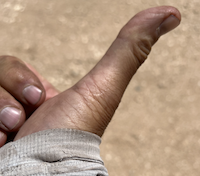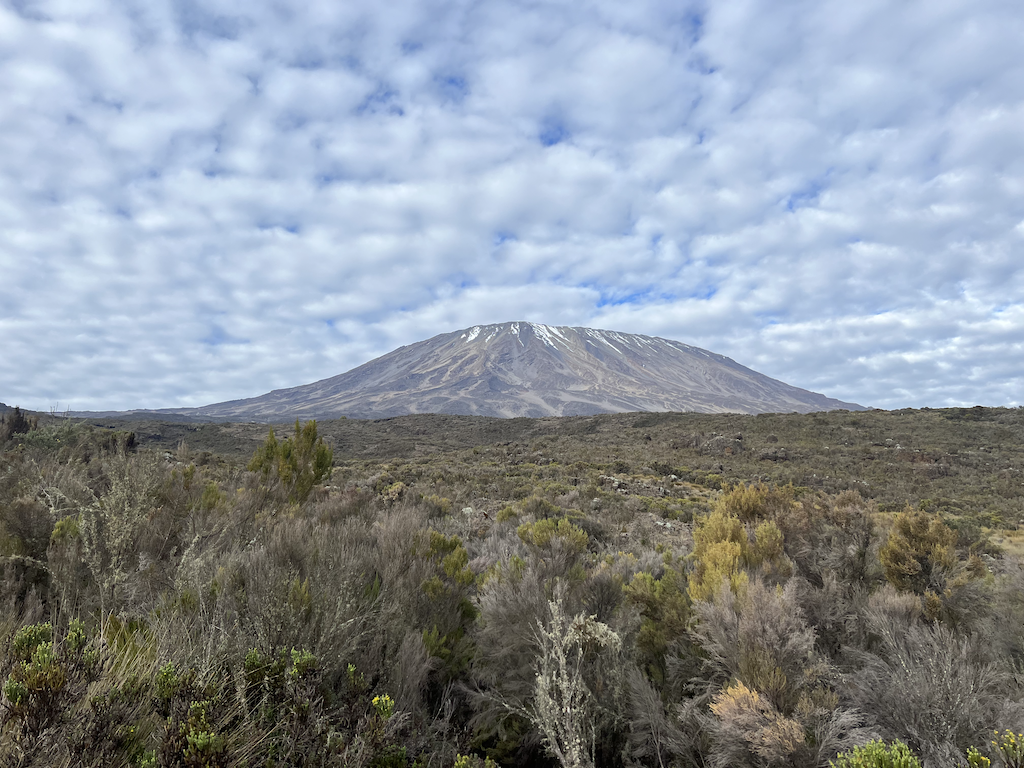
I did it! I safely summited the highest point on the African continent. This adventure had many firsts for me. I had never been to the African continent, been above 14,200 ft, slept above 11,500 ft, and had a guide or porters. I have never done mountaineering, so I learned and experienced the process on a relatively easy mountain.
The primary risk of summiting Mt Kilimanjaro is altitude sickness. Having a good guide and team reduces this risk, but the danger is omnipresent until you reach the peak. I recommend preparing for biting cold and wet conditions and being open-minded to suggestions and recommendations before, during, and after completing the climb.
I had the advantage of having a friend, Brad Clement (https://spindriftfilms.com/), who leads expeditions and lent me his knowledge, and I could use his team in East Africa.
How did this adventure all come about? I had a trip planned for fall 2022, but nature nixed this plan. That adventure would have several firsts for me, so I wanted to find a similar expedition with aspects I had never done. Friends Tonya and Brad, who have been worldwide climbing mountains, said that one of their favorite places was East Africa. We discussed climbing Mt Kilimanjaro. My main concern was having no mountain climbing experience. Would this trip suit me?
Tonya and Brad were supportive. They knew I backpack and am athletically inclined. Brad encouraged me to investigate group ascents, which are cheaper. Being a solo hiker, I was attracted to a private trip, and I clinched the deal with Brad because he suggested doing a lesser traveled route that also served to acclimatize to altitude best.
Brad explained that 30% to 40% of people fail to summit Kili because of altitude sickness, and Kilimanjaro has no technical challenges. Brad has led nineteen trips up Kili and will do another in August 2023, so he has experience. He suggested that doing Kili in the dry season is best, and there was a dry window in January-February and another in our summer and early fall.
I wanted to go soon, so I picked dates, committed, and made arrangements. I would leave Colorado on February 15, 2023, and return on February 28, 2023. I only did Kili and did not take side trips like doing a safari or touring the country. Safaris are about riding in a vehicle so that participants can see a lot, but I wouldn’t say I like sitting around.
Arriving in Tanzania
The flight from Denver to Tanzania was about 30 hours. I got my visa in Tanzania when going through Immigration. Sammy, Brad’s brother from another mother, heads Brad’s team in Tanzania. Sammy met me at the airport along with my guide, Hallelujah. By Tanzanian law, all trips into Kilimanjaro National Park must have a guide. Hallelujah picked the team of porters and cook.
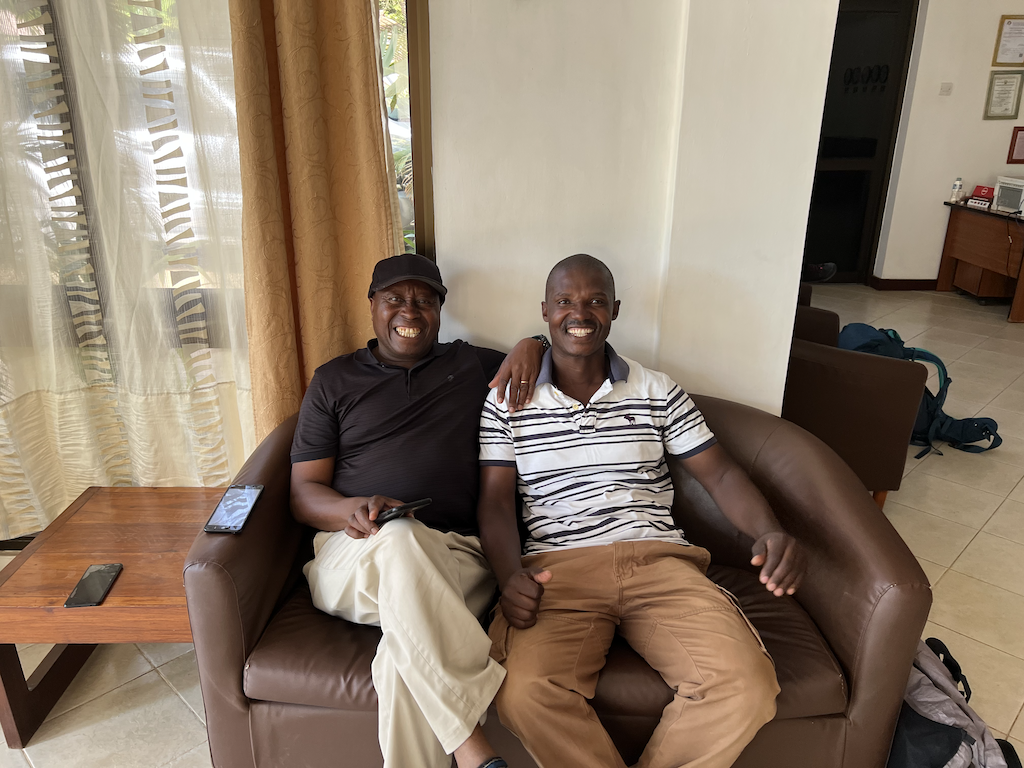
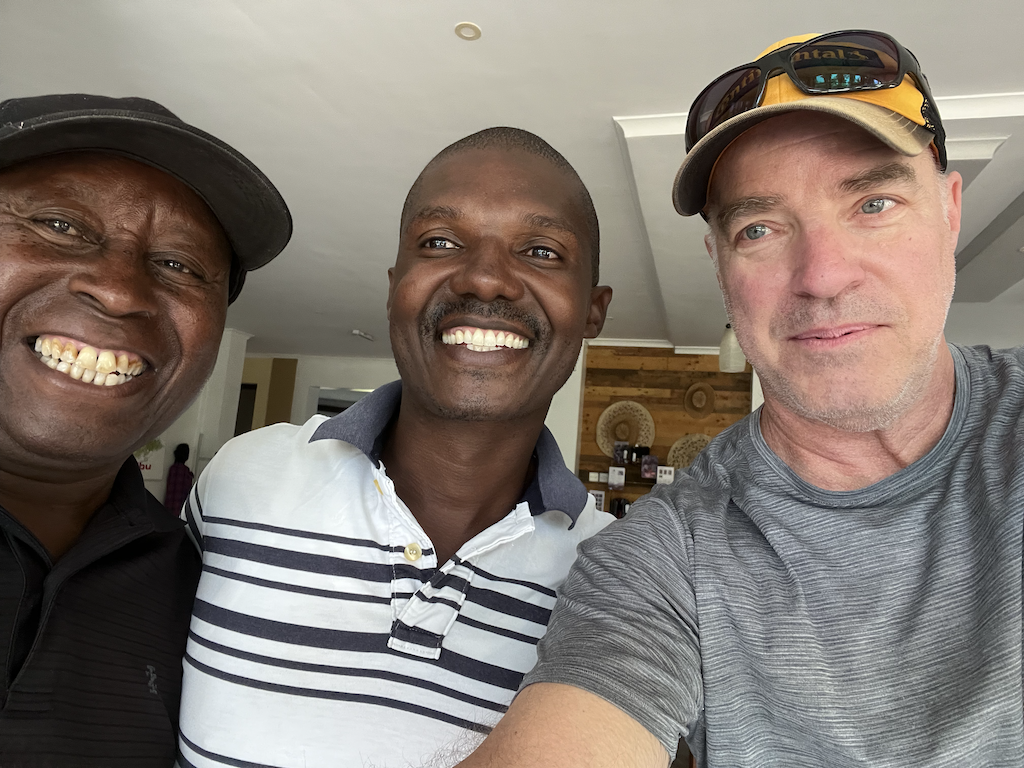
The cost included the hotel, guide, porters, cook, food on the mountain, park fees, and logistics. Sammy and Hallelujah even showed me around Moshi, a town at the foot of Kilimanjaro, and we did a short hike on the jet lag rest day to a beautiful waterfall.
The day after I landed, Sammy and Hallelujah took me to Materuni Falls, a short hike outside Moshi. Moshi sits at the foot of Kili and is at 3,120′. Materuni Village is at 5,900′ and is at the edge of Kilimanjaro National Park. This day was a rest day to help recover from jet lag. The hike was beautiful.
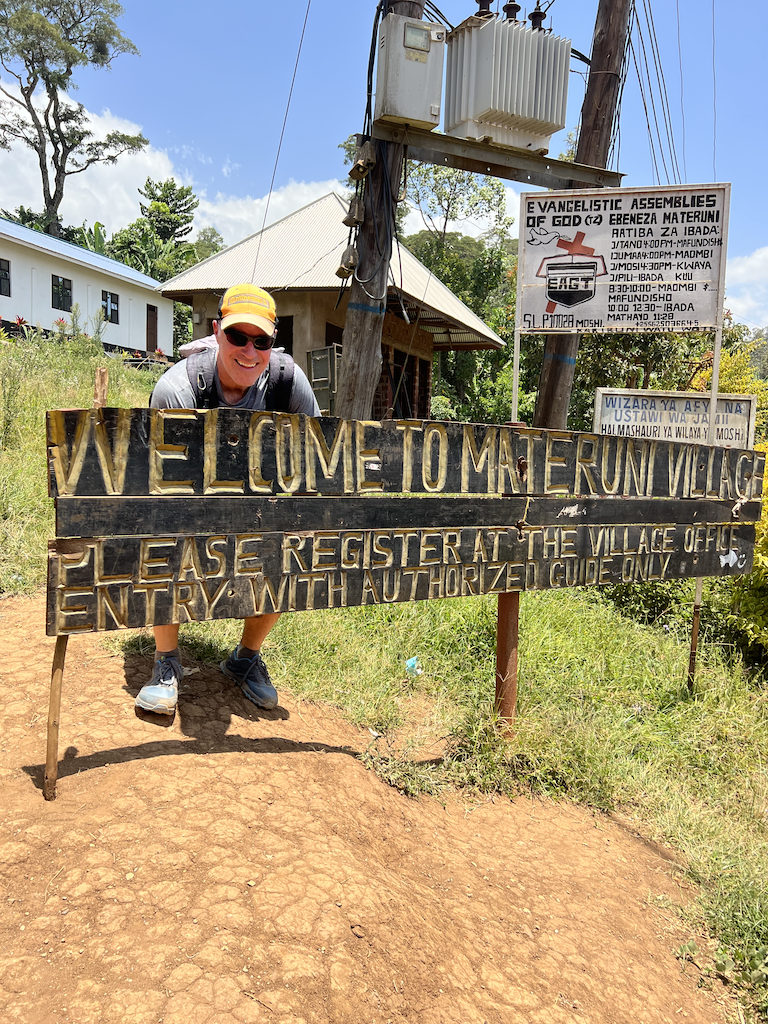
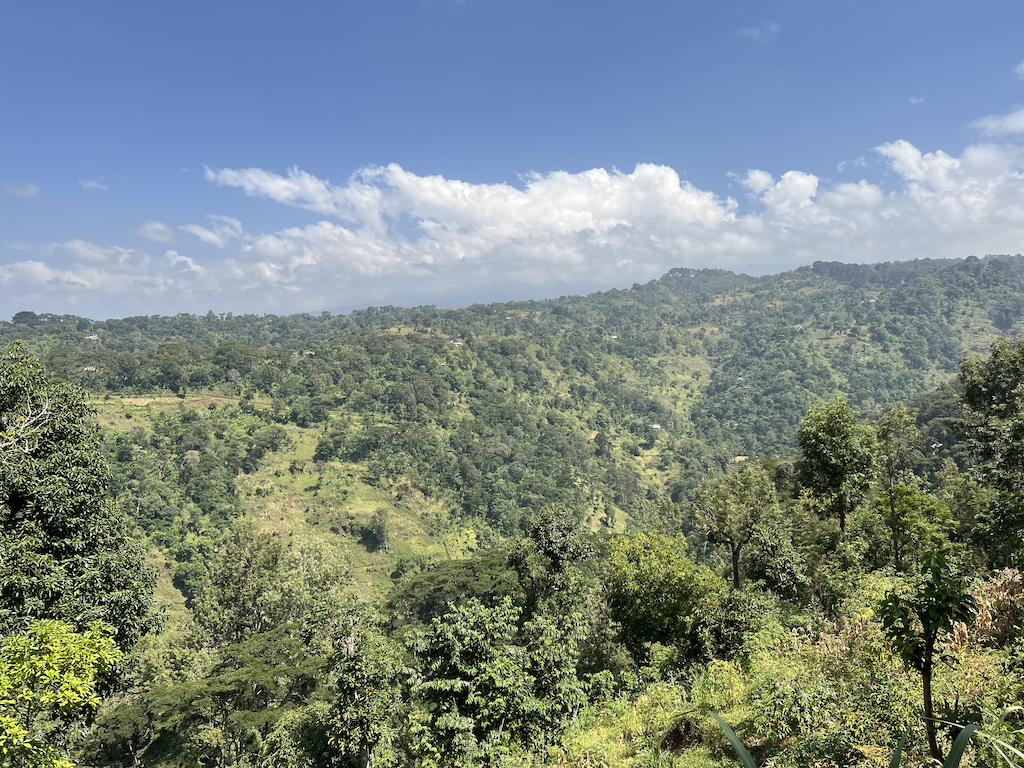
Coming from Colorado in February, green is not a color I often see, so when the trail emerged onto a vista, I had to take a picture. The hike took us along a dirt road where the inhabitants farmed corn, sunflowers, bananas, oranges, limes, passion fruit, and coffee. We stopped along the way and bought some small bananas and passionfruit. Flowering plants and trees lined the path. Closer to the falls, the road became a single track.
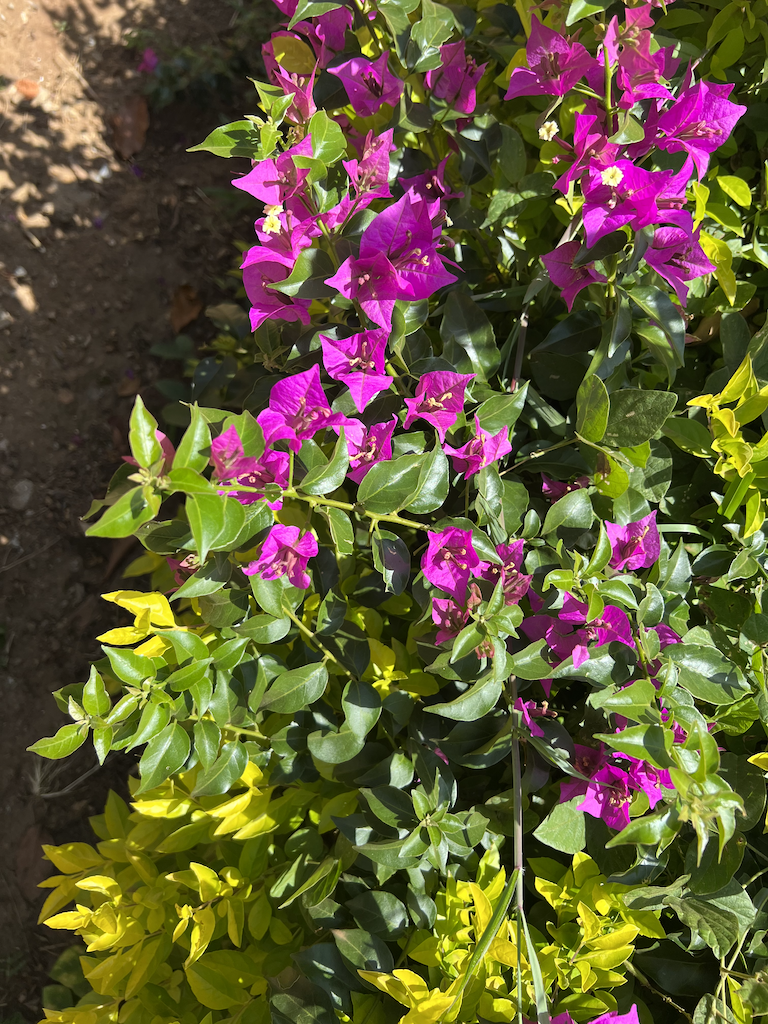
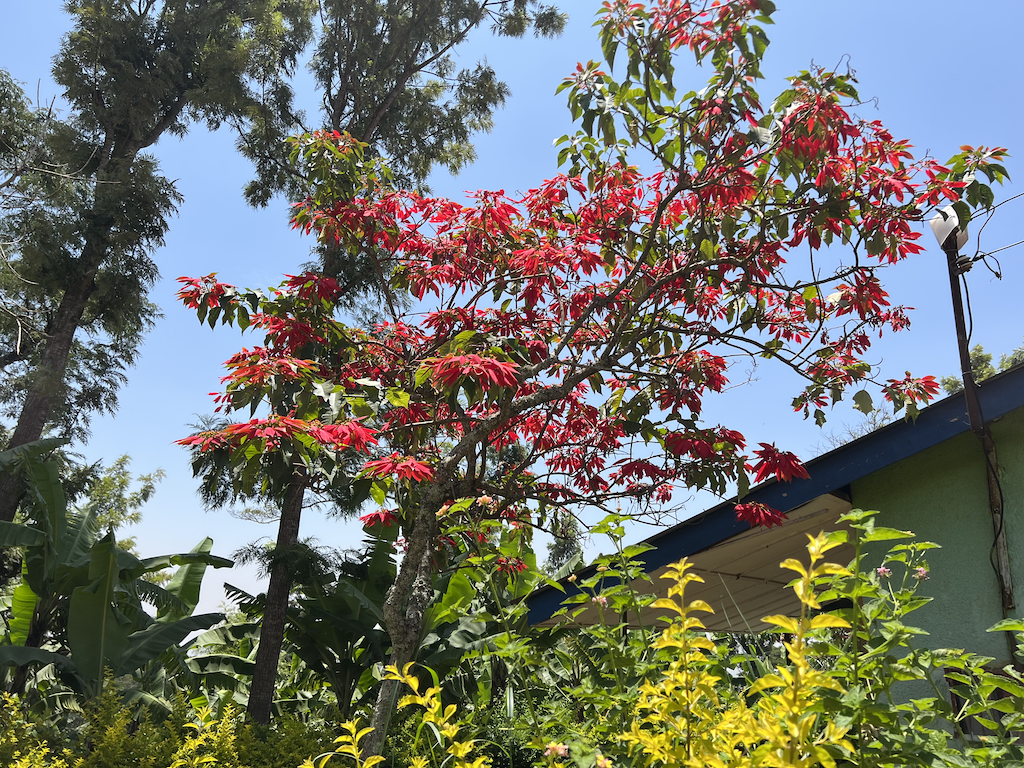
The falls are even more beautiful than the hike to the falls. The water was cold even though the ambient temperature was in the mid-70s. The falls are popular with visitors, and we passed a dozen groups heading to or returning.
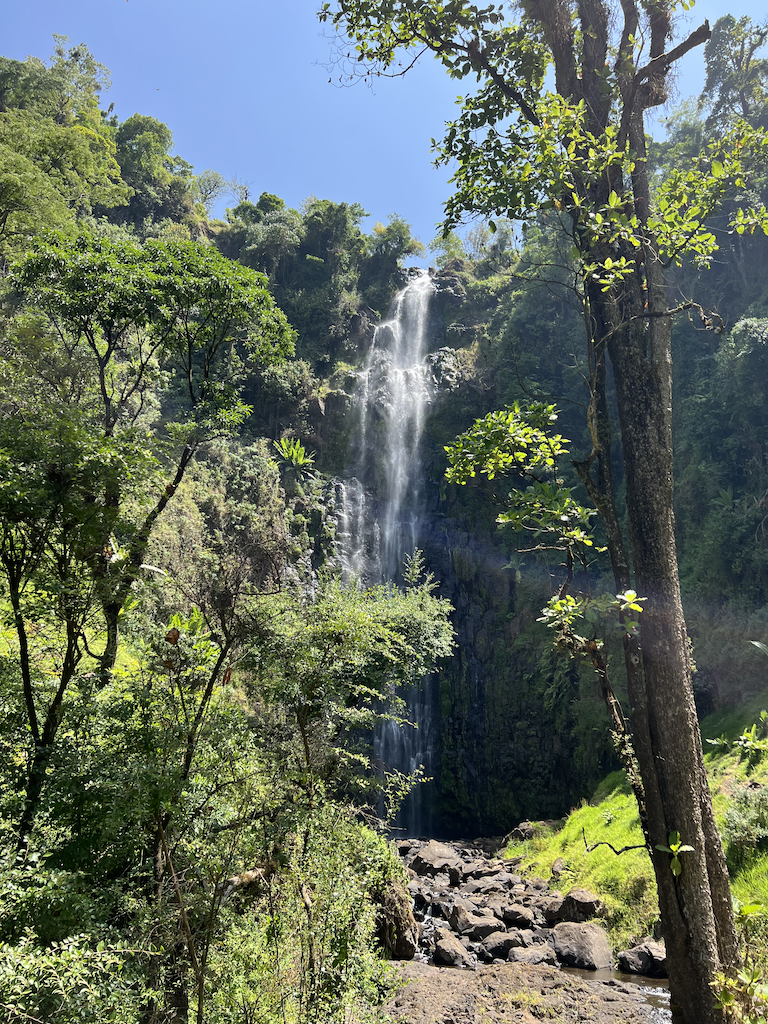
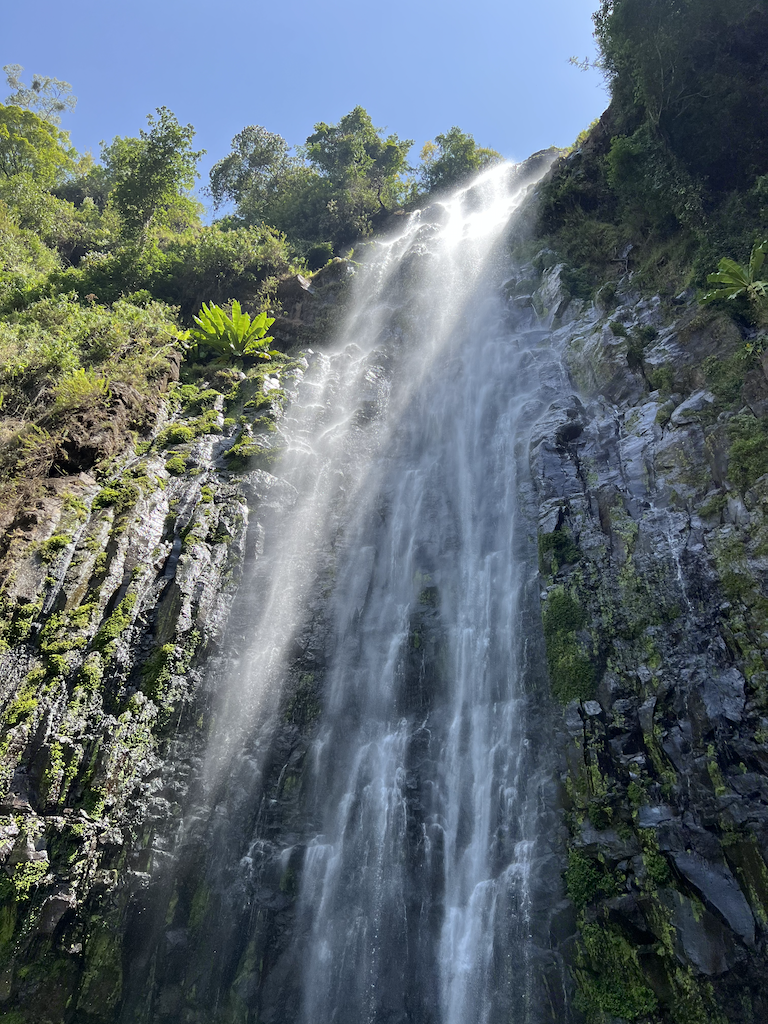
After returning to Moshi, Hallelujah and Sammy took me to the local market to show me where our food comes from. The fruits, vegetables, potatoes, onions, garlic, ginger, eggplants, grains, and rice are all local. I was amazed at how fine-looking and ripe they were, particularly the tomatoes. The market was like the market I frequented in Labuan, Malaysia, when I was much younger.
The Climb
I did the Rongai route, which starts at the north face of Kilimanjaro National Park. Moshi is south of the park, so we had a three-hour drive to the Rongai gate, which is why the Rongai route is not crowded.
Tour group websites purport other routes are more scenic, which did not matter to me since the environment was all the same once above the treeline. Acclimatizing to the altitude to get to the summit is why I am there. The bonus of feeling more remote and not crowded was ideal for me.
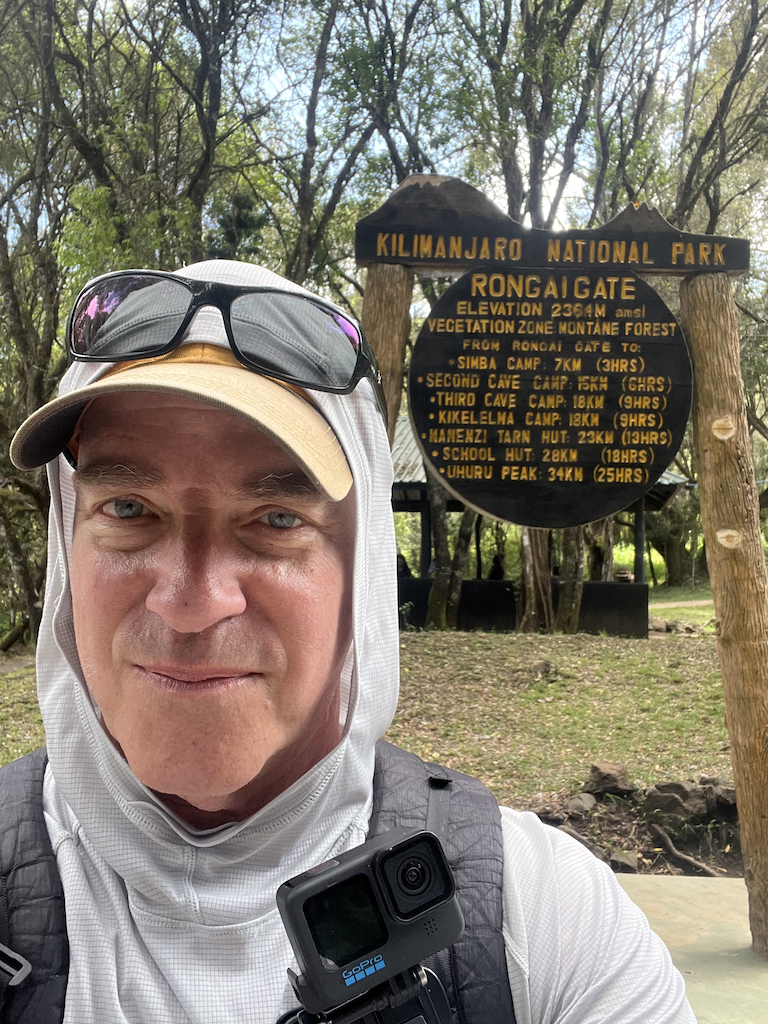
While the team organized our gear, I explored the Rongai Gate area. A point of discomfort for me was I was discouraged from helping. Brad warned me about this, but I still tried. My responsibility was only packing my daypack and bag for the porter to carry and get to the top of the mountain. Protocol tasked my team with getting me to the top, and I felt responsible so the team could also celebrate. Brad told me that the team relies on tips to augment their income, so helping and failing to summit risks the amount of gratuity. In addition, the metric of success adds to a team’s reputation.
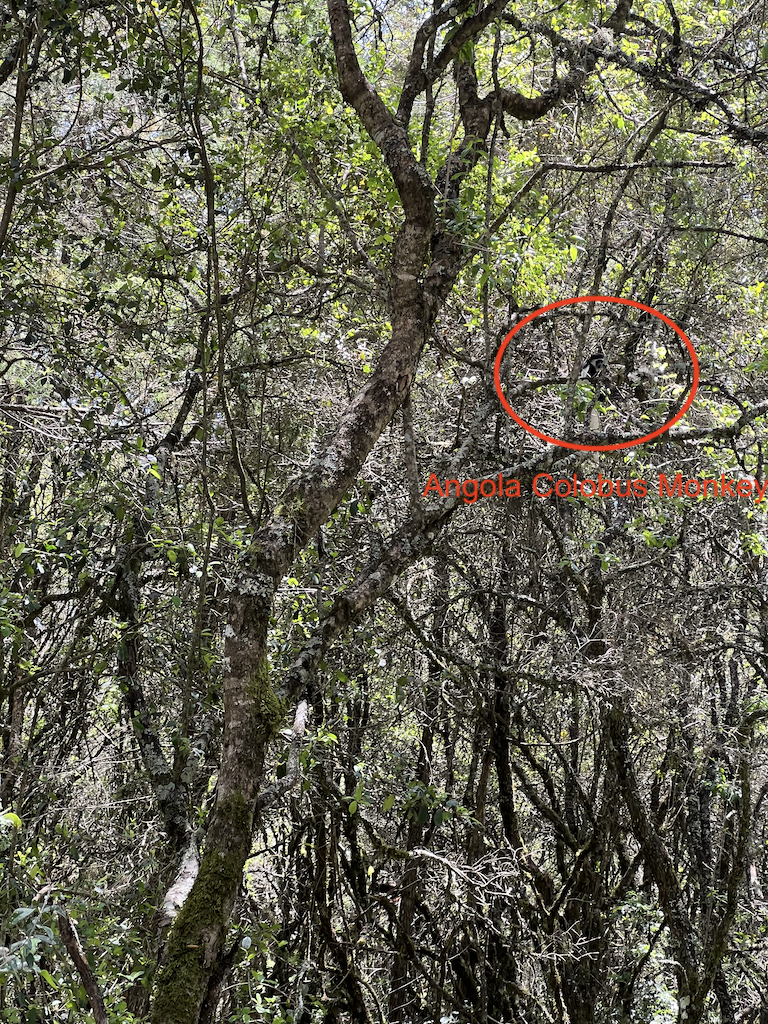
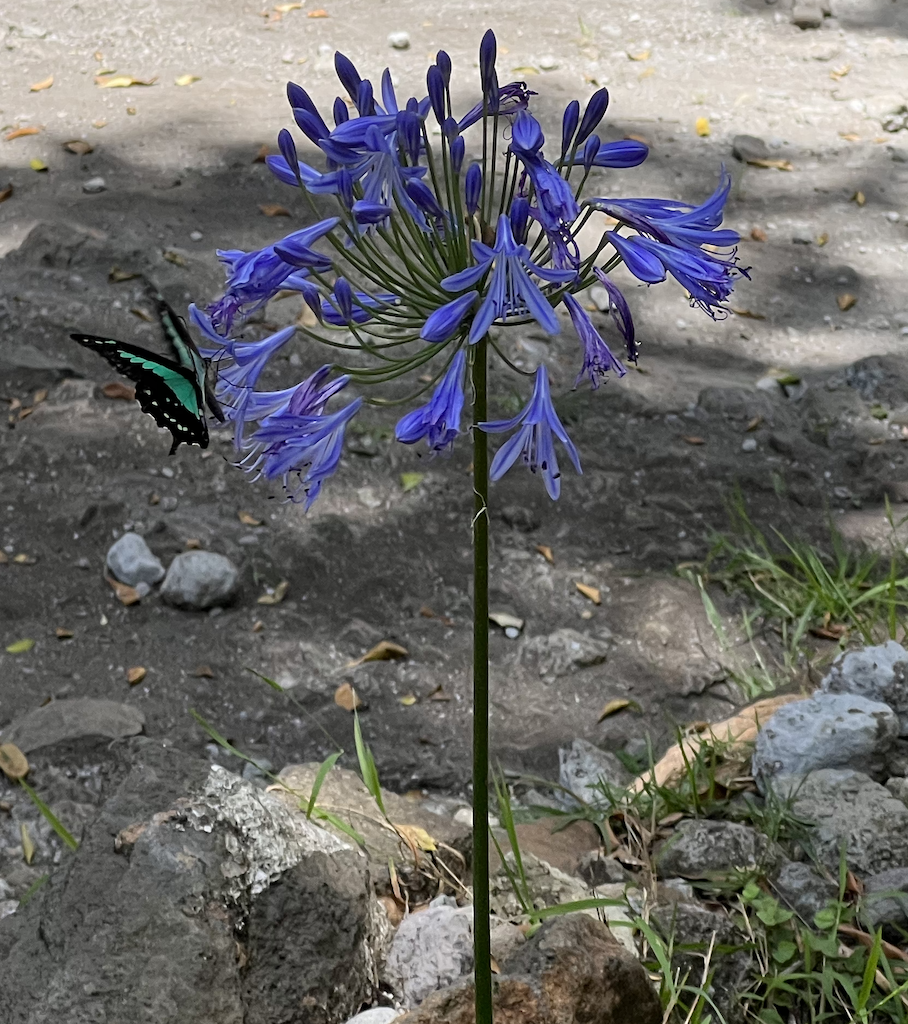
There are five vegetation zones on Mt Kilimanjaro. We drove from the cultivation zone to the rainforest zone to start the climb and quickly arrived in the Moorland zone (grasslands) at our first stop, Simba Camp, at 8,763’.
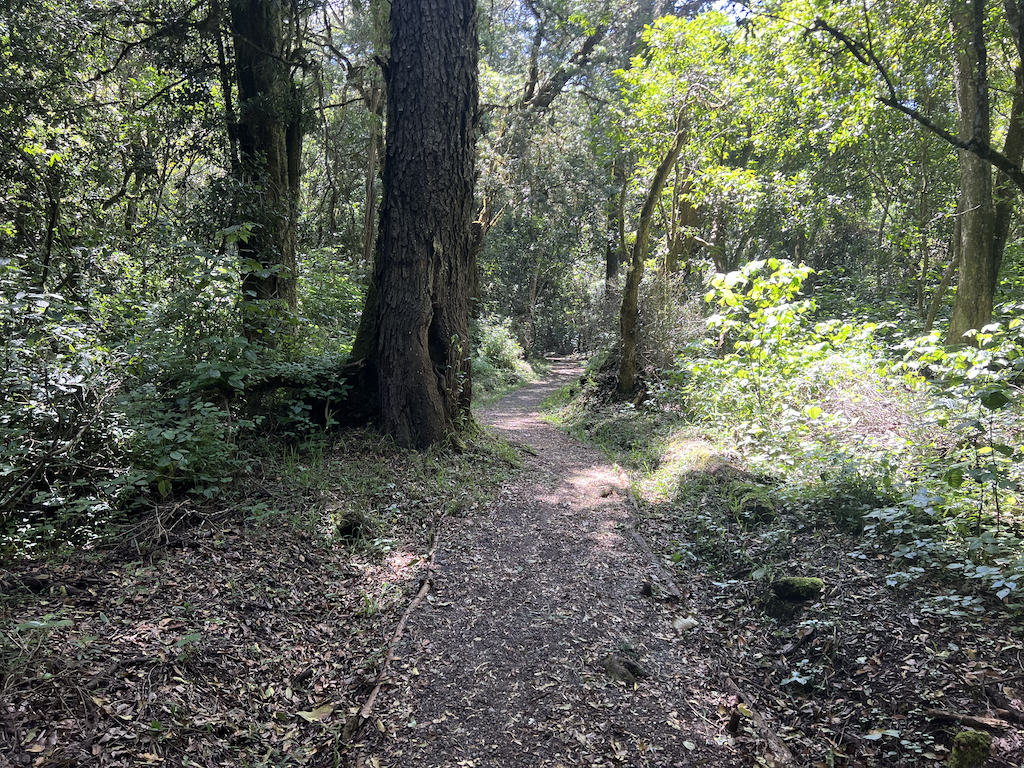
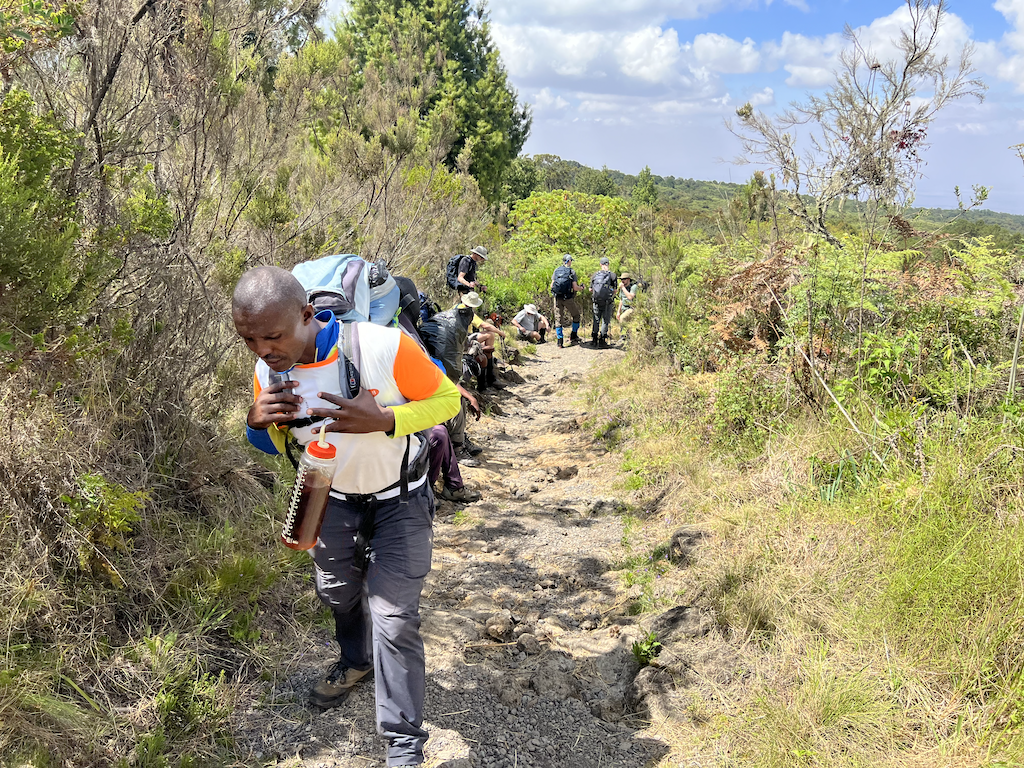
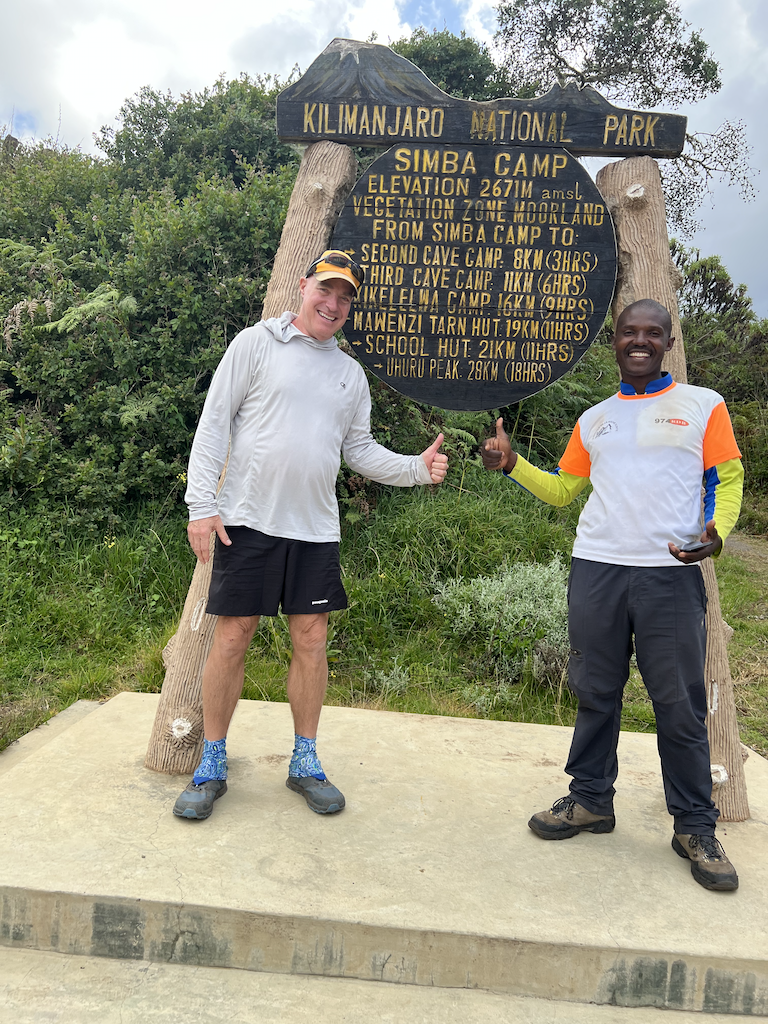
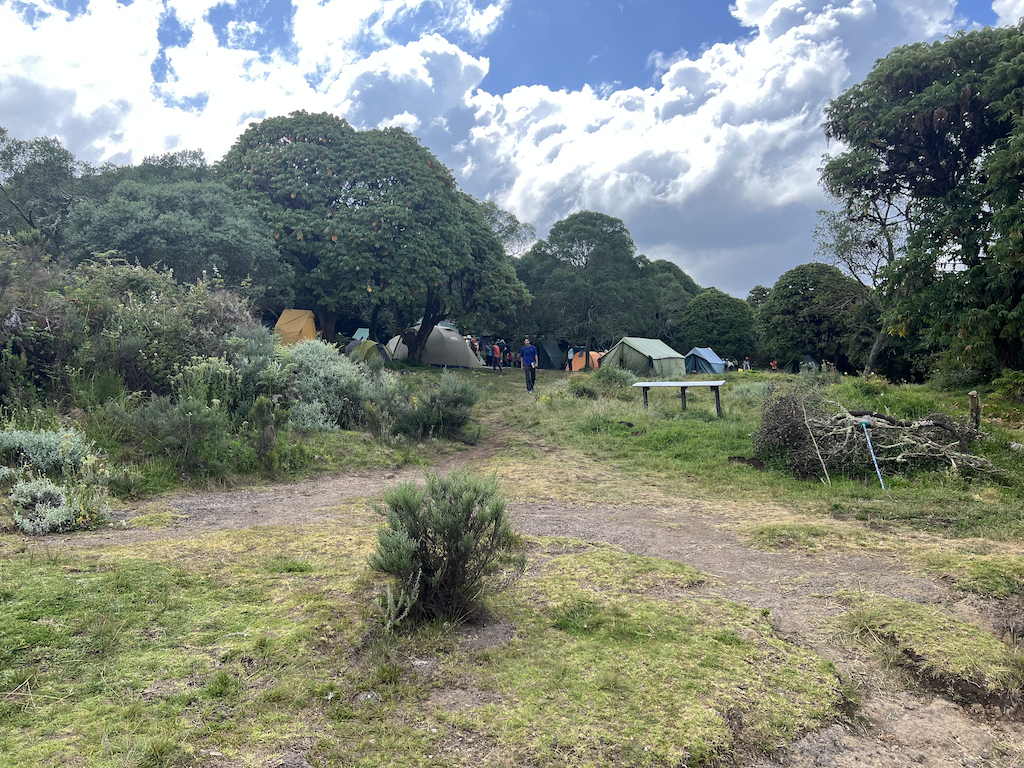
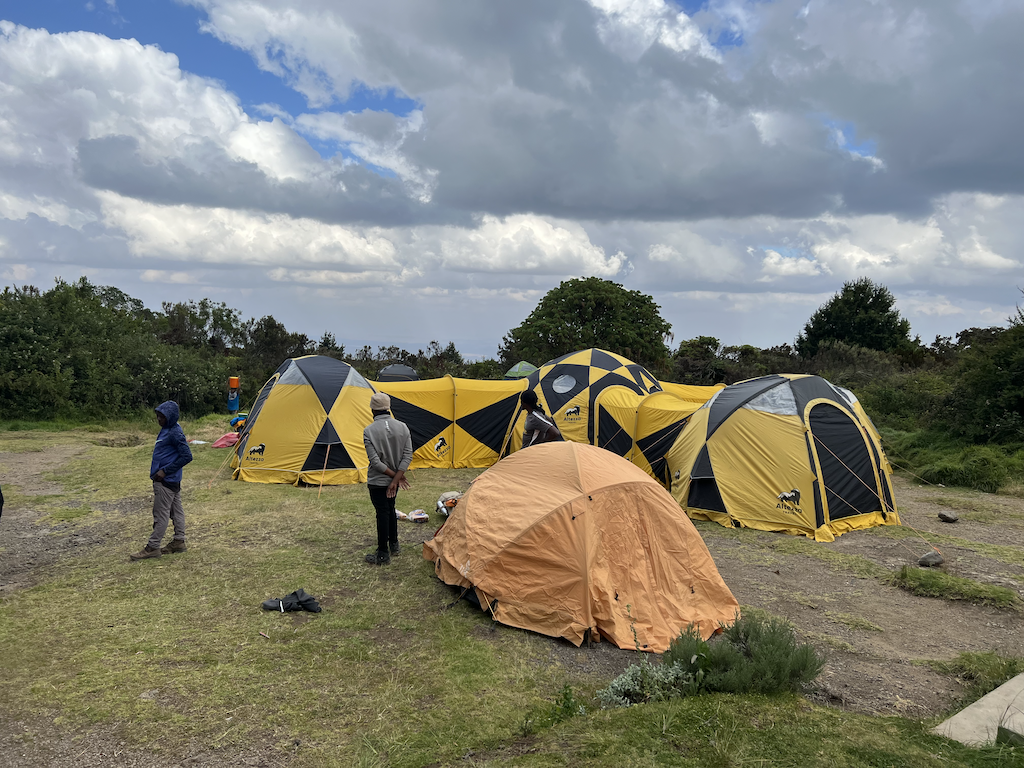
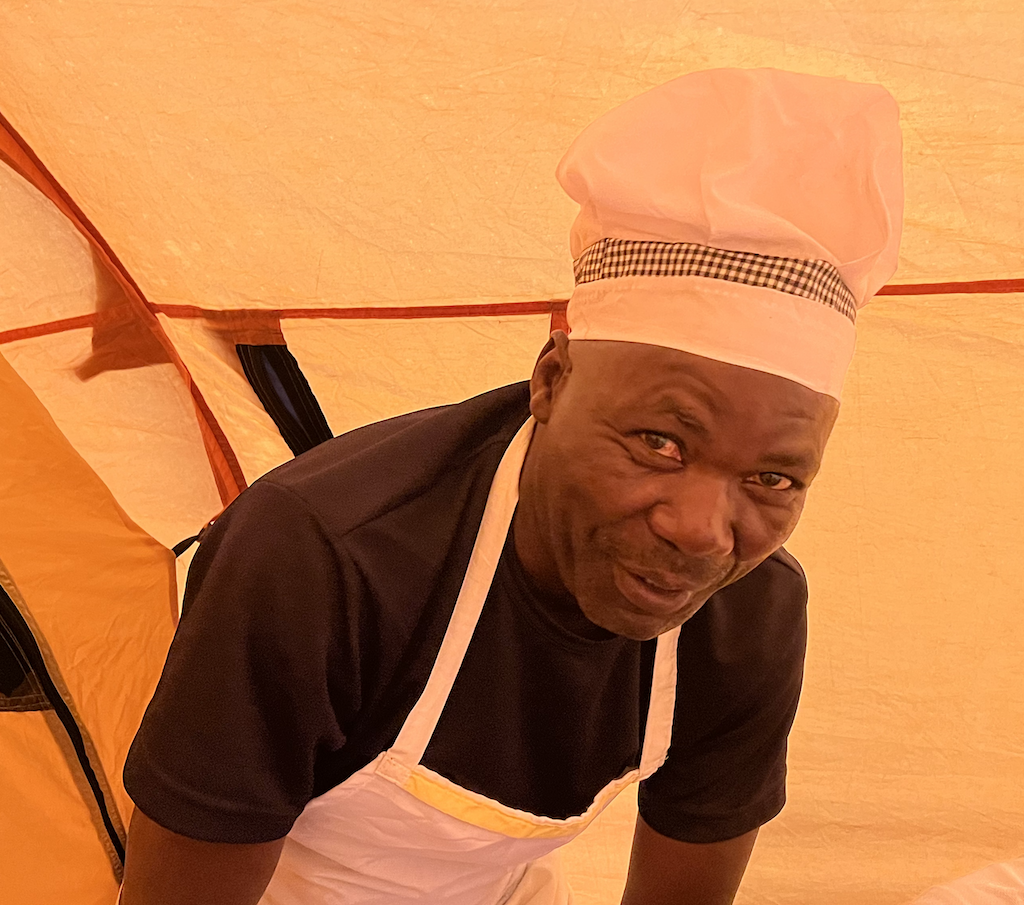
Every night, we camped at established campgrounds, which were close to water sources and had pit toilets. The daily regimen was to rise around 07:00, have a big breakfast, start hiking about 08:30, get to the next camp between 11:00 and 11:30, have a big lunch, rest, do an acclimatization hike for a couple of hours, have tea and snacks, rest, have a big dinner and retire for the night.
My team was excellent. Bongo, the cook, prepared delicious, hearty food, and PLENTY of it. The food was always fresh, including eggs, fruit, chicken, pork, and vegetables. I felt guilty when I could not eat everything in every course. I had to pace myself through each meal; otherwise, I would eat the entire first course without room for the last dish. Not a bad problem to have. Luckily, the team would finish any chow I did not.
My team would set up camp, and Hallelujah would give them a talking-to in Swahili if anything were not up to his standards, like site selection, timing, cleanliness, etc. I never noticed; however, the standards expected were high. Hallelujah also conveyed praise when I mentioned how hard they worked.
Sammy told me before the trip that chocolate was scarce and expensive in Tanzania. I do not eat chocolate when I backpack because it melts; however, I bought enough big Hershey Bars for the team. Hallelujah passed these out each day.
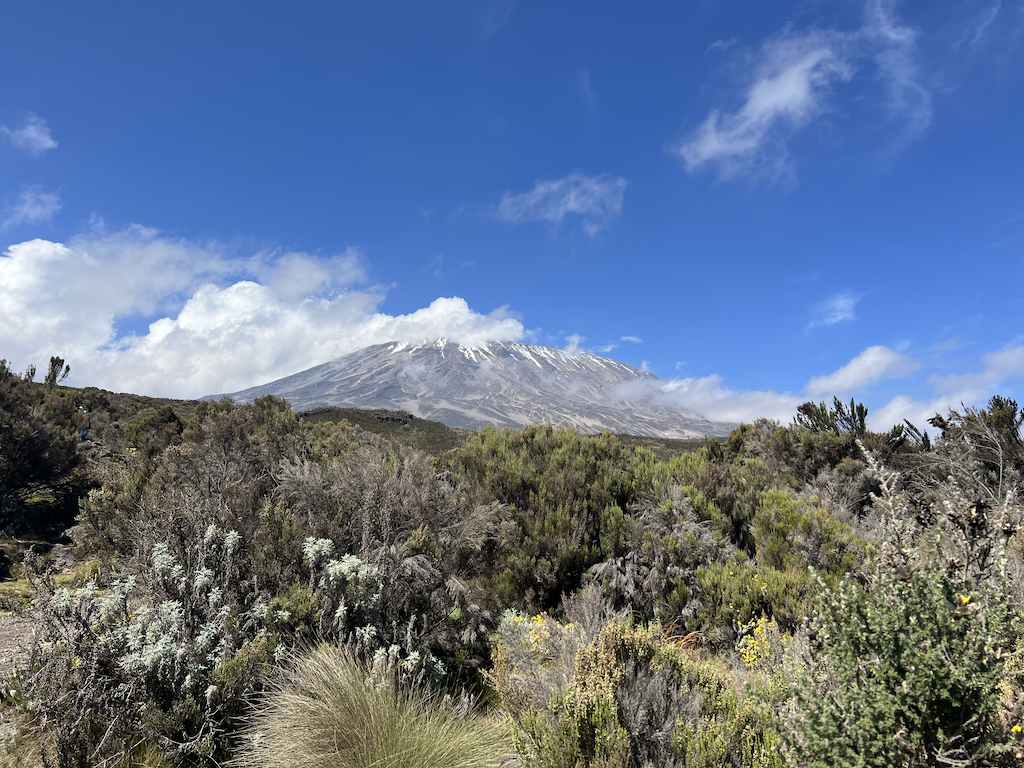
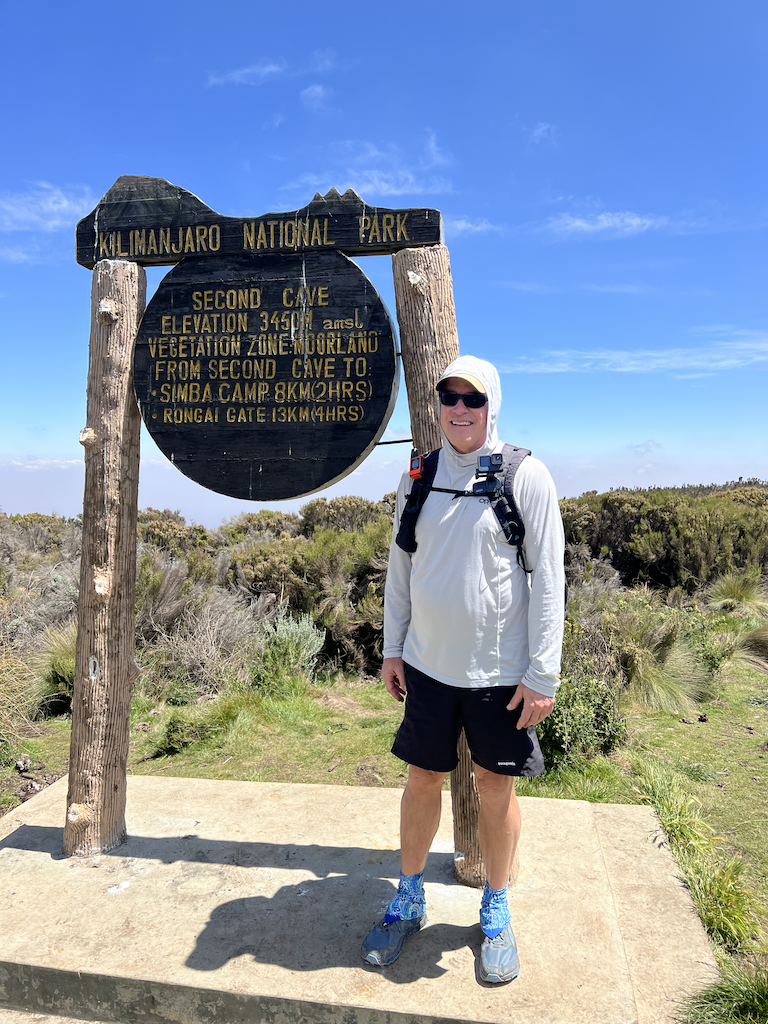
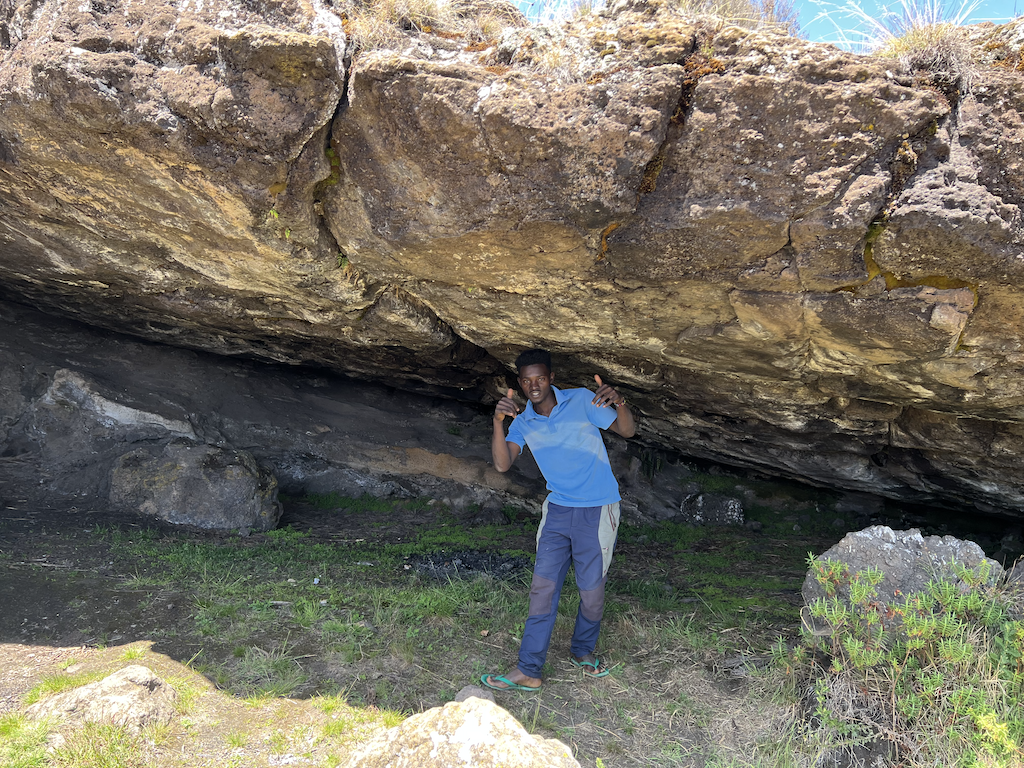
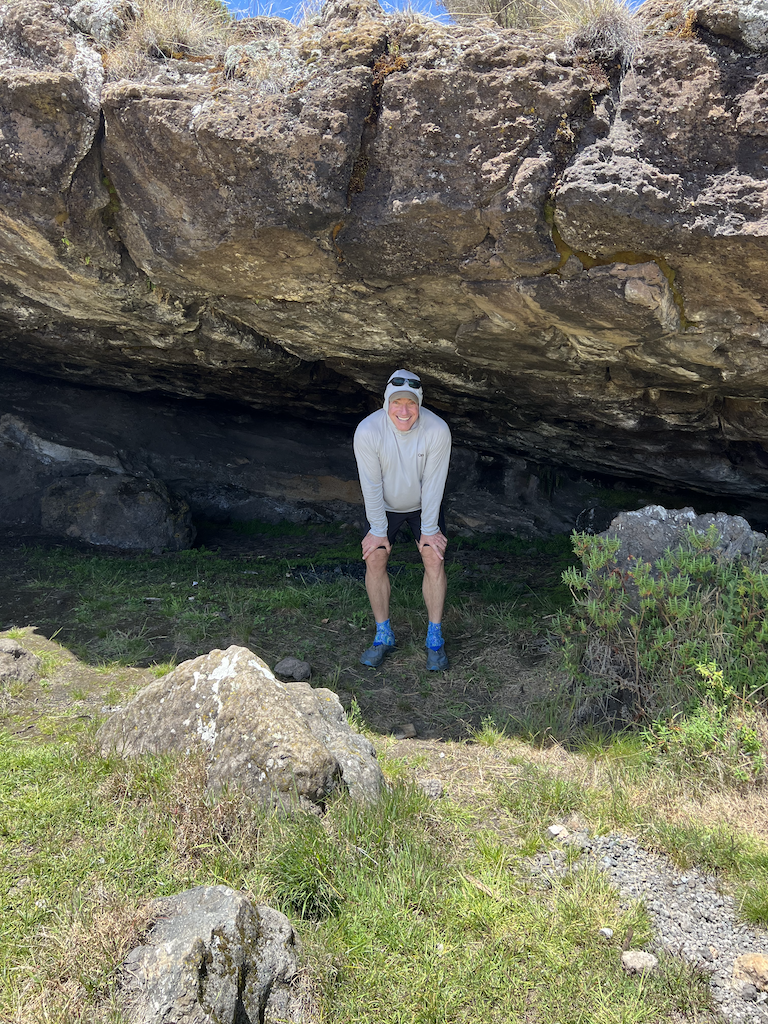
After the Second Cave Camp, the crowd of hikers disbursed. Some headed the School Hut way, some had not planned to summit, and some went the same way we did. Our next campsite was Kikelelwa Camp (11,810’), near a cave with the same name. The Kikelelwa Cave was large enough so Hallelujah and I could explore the cave for 100 yards. The pictures we took did not come out well.
On this day, we had a short distance to hike and just five hundred feet of elevation gain. Brad designed it this way to help with acclimatization. Hallelujah and I went on another acclimatization hike in the afternoon. We looked at the flowers and foliage, which Hallelujah explained. We saw several instances of Cape Buffalo tracks. Hallelujah explained that Cape Buffalo could be very aggressive and are on the upper slopes of Kili as they follow the water.
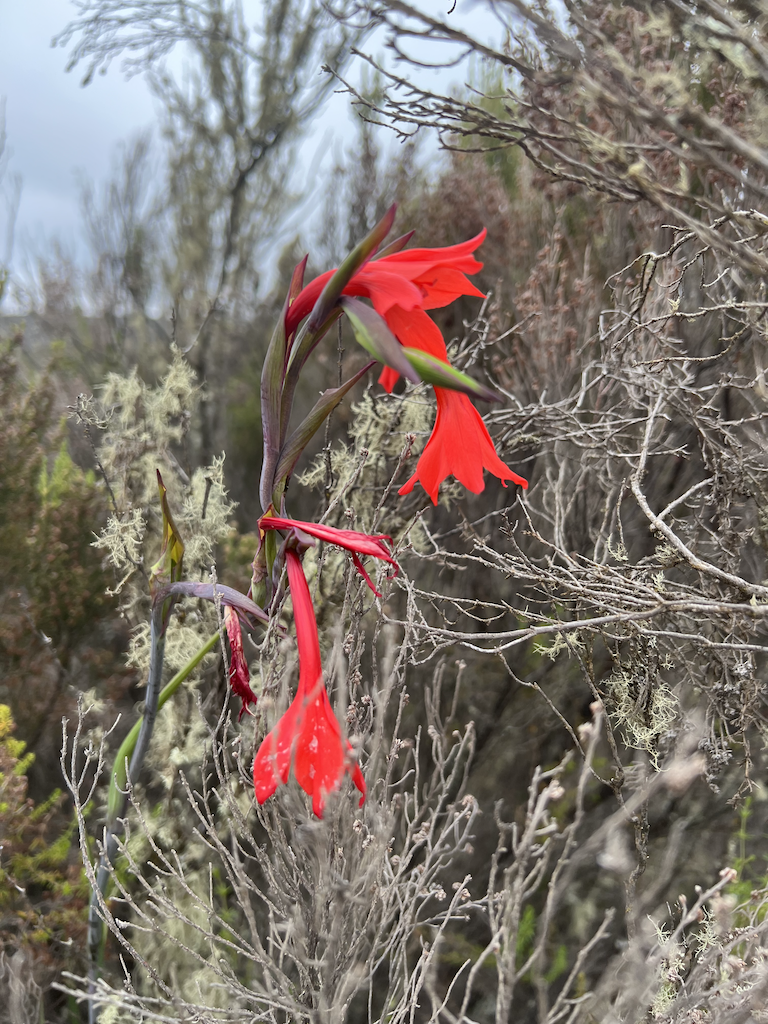
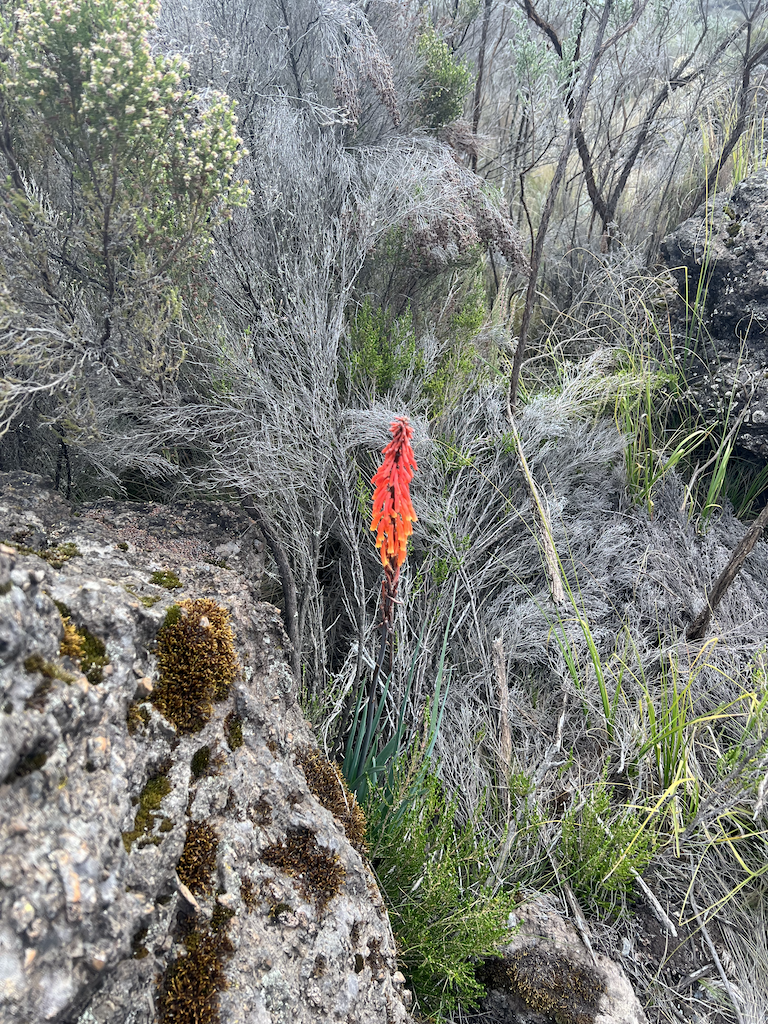
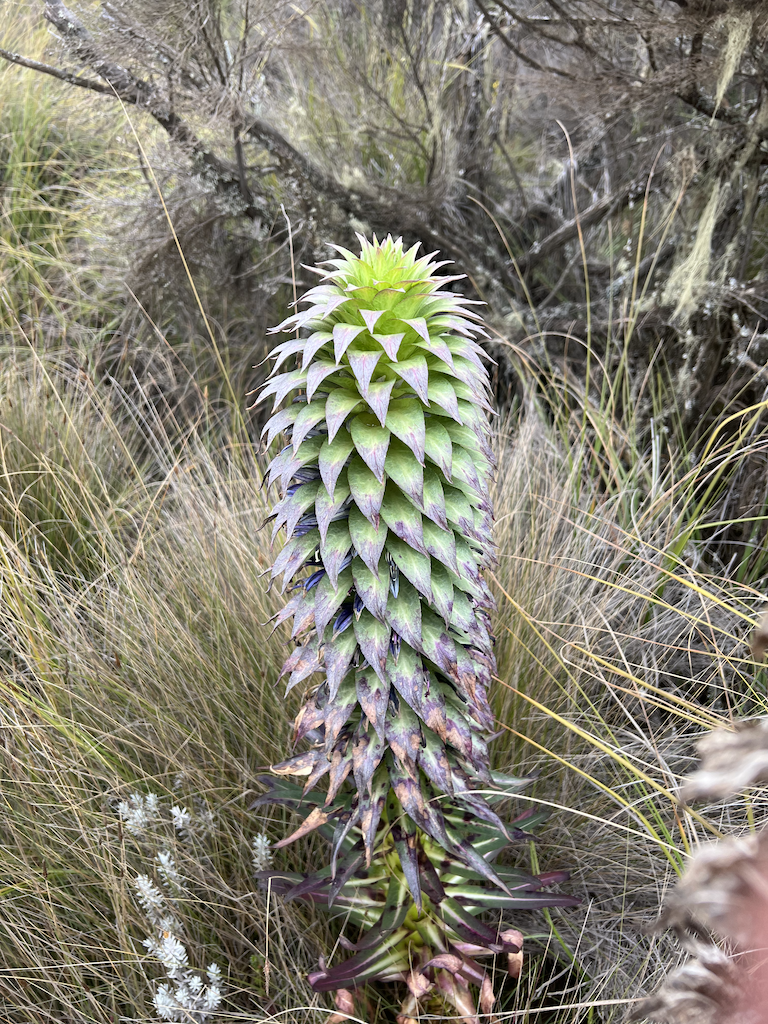
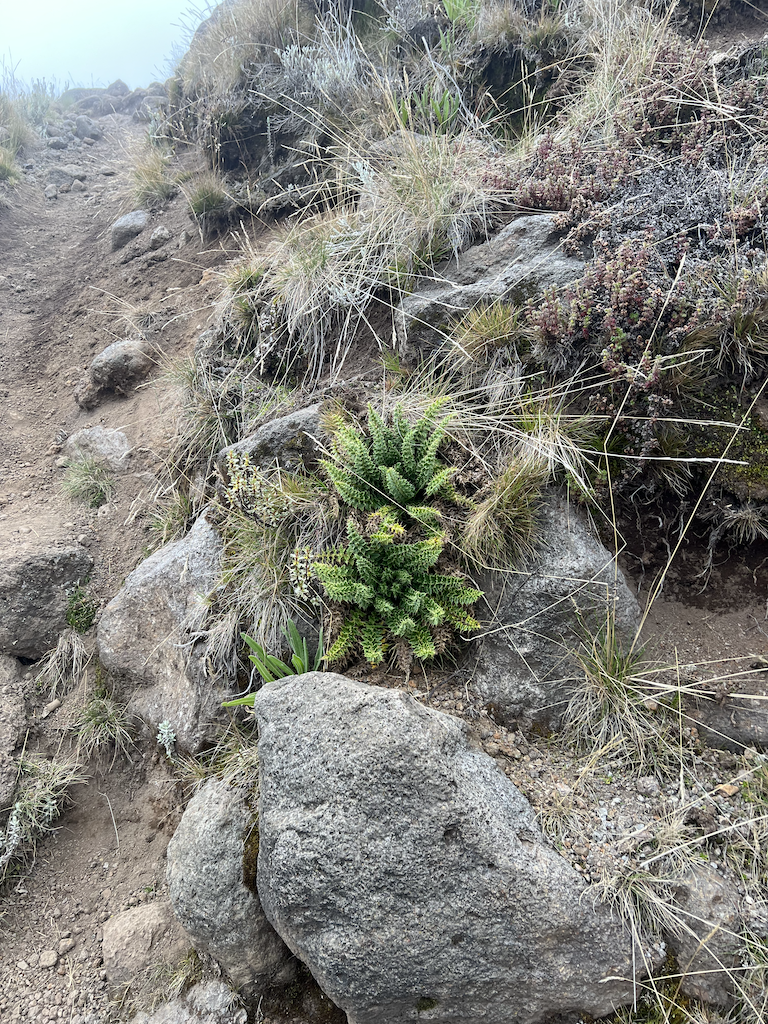
The gladiolus and red hot pokers with their red flowers stood out in the desolate upper elevations. The Tussocks are grass that grows in bunches. They have long roots to gather moisture during periods of drought. The Cape Buffalo eat the Tussock as they migrate. They bite off the grass about 2-3” from the root to allow the Tussock to regrow. The senecio kilimanjari and lobelia deckenii are the most unusual.
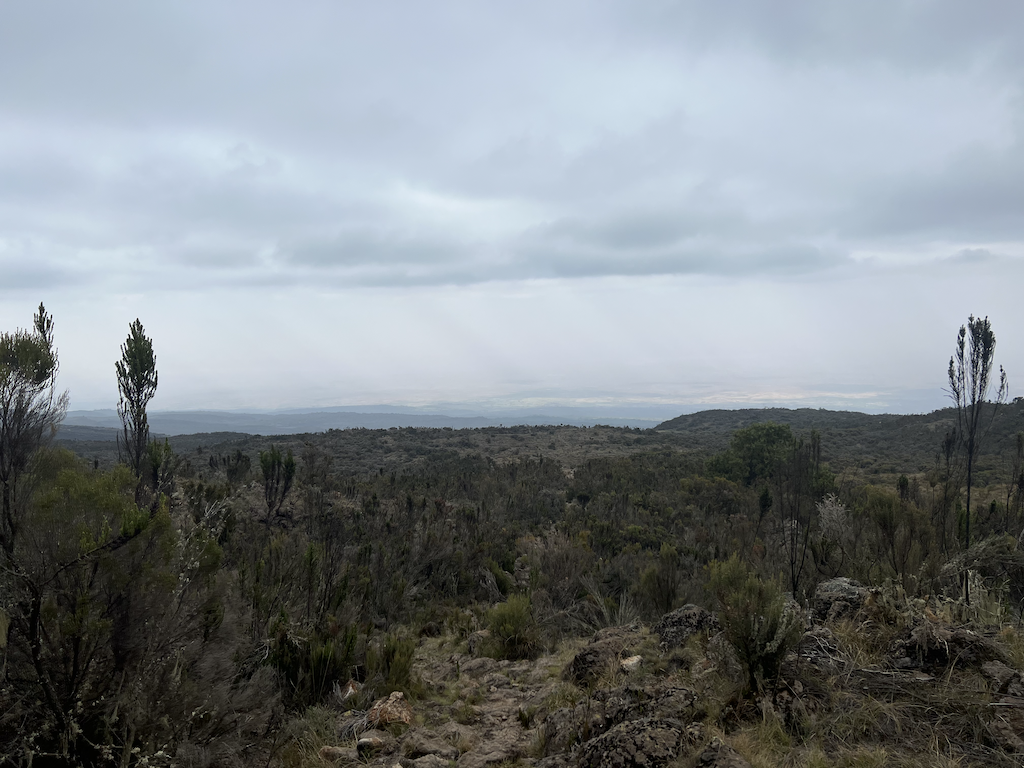
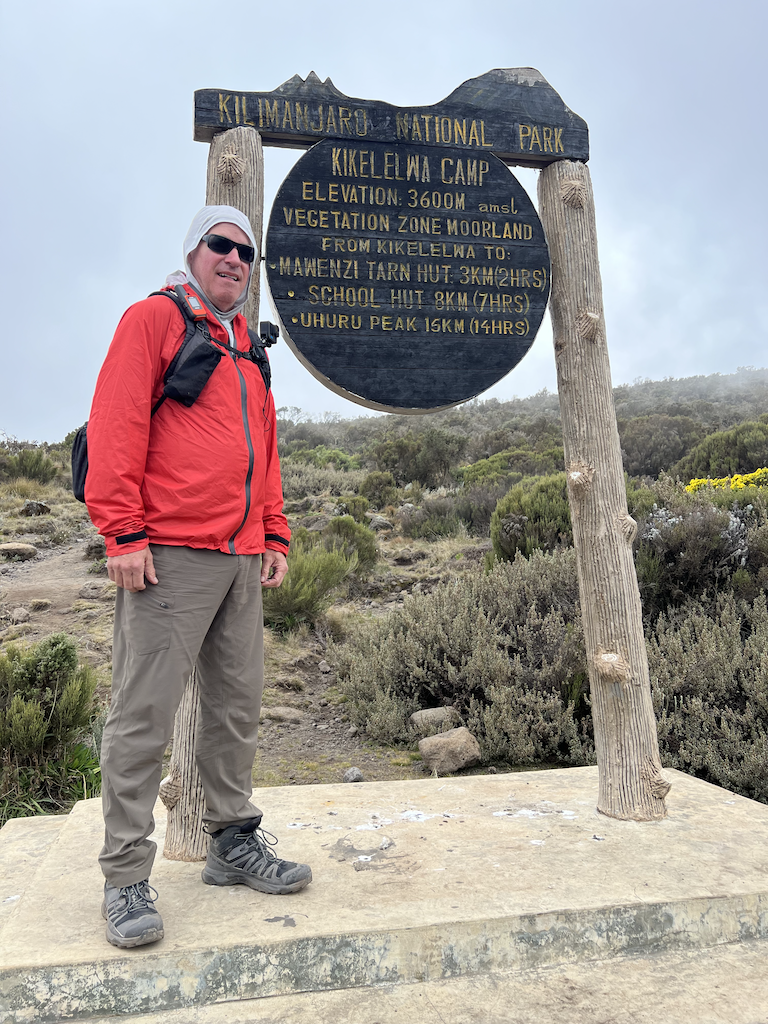
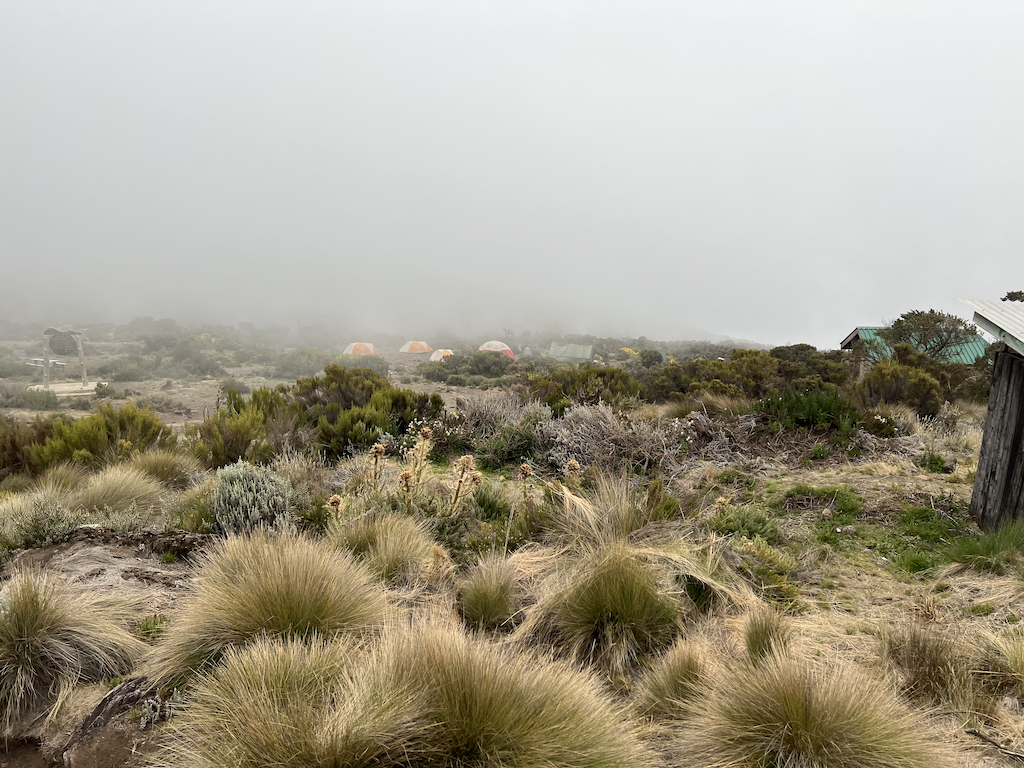
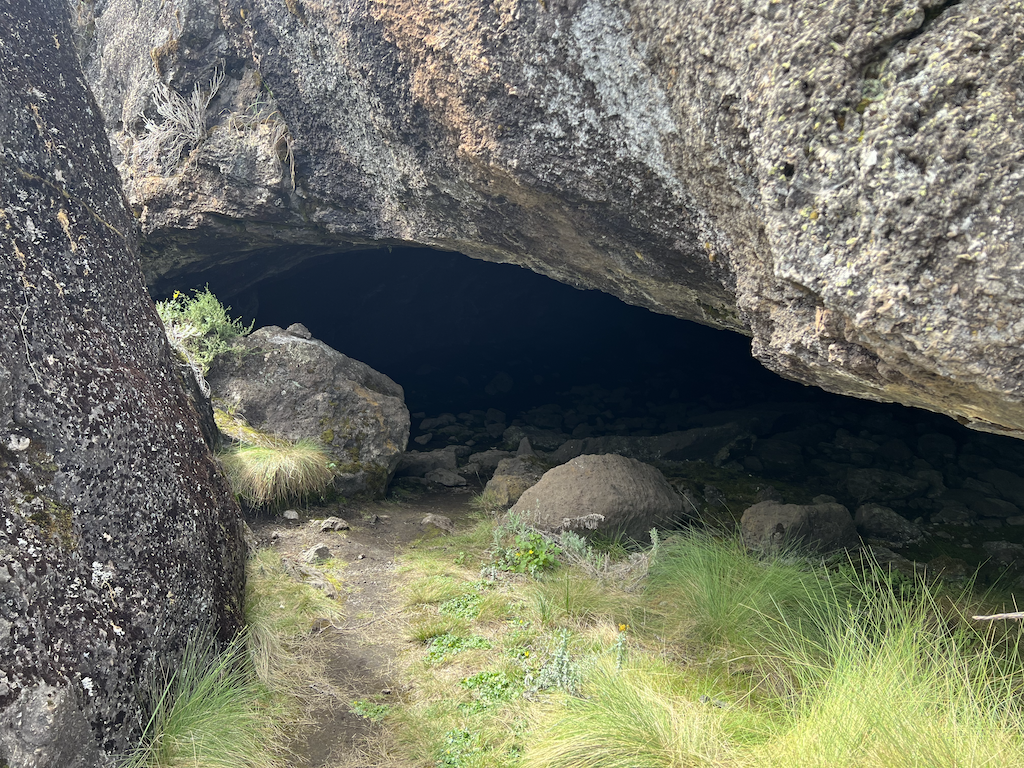
I had developed a muscle knot in my left quad, which took about twenty minutes of hiking to loosen. I told Hallelujah about this since he said he sometimes gets them when he sleeps on his side. I am a side sleeper, too. He was not concerned but wanted to keep an eye on it because it could prevent me from summiting. Fortunately, the short hike to Kikelelwa Camp was the worse day. I drank plenty of electrolytes, took ibuprofen, and massaged the quad. The next day it was tight and again loosened within twenty minutes. For summit day, it was not a problem.
The next stop was Mawenzi Tarn Hut (14,160’) at the foot of Mawenzi Peak (16,893’), the third-highest peak in Africa. A tarn is a mountain pond formed in a cirque excavated by a glacier. The tarn was low when I was there, and we did not get water from it.
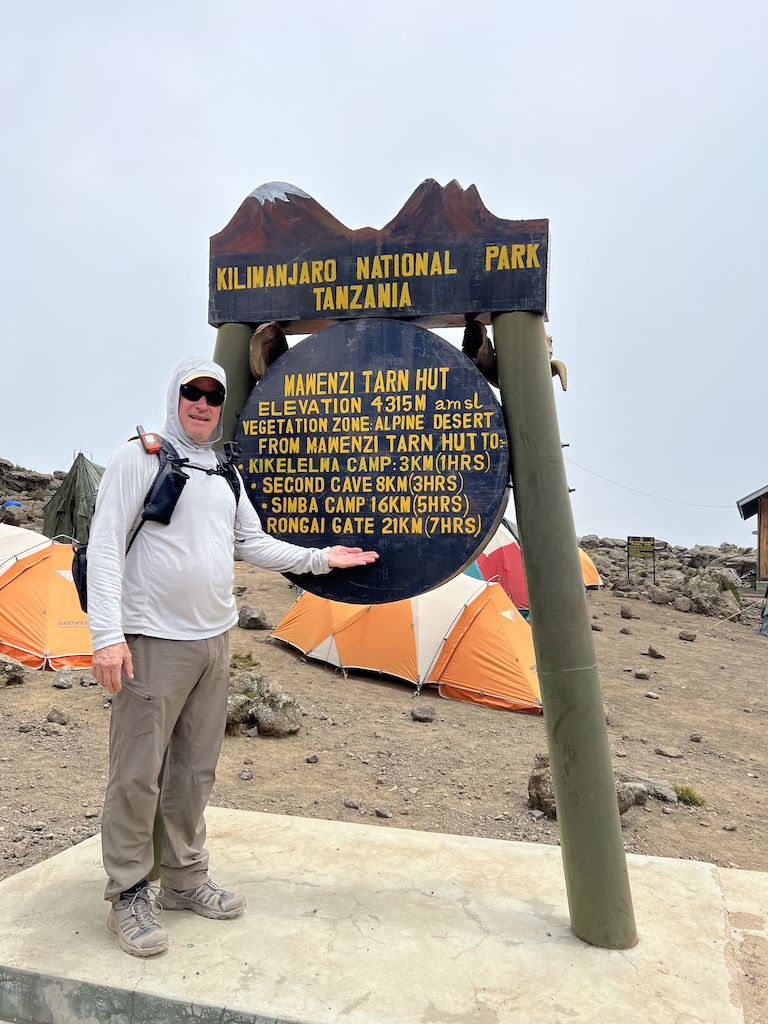
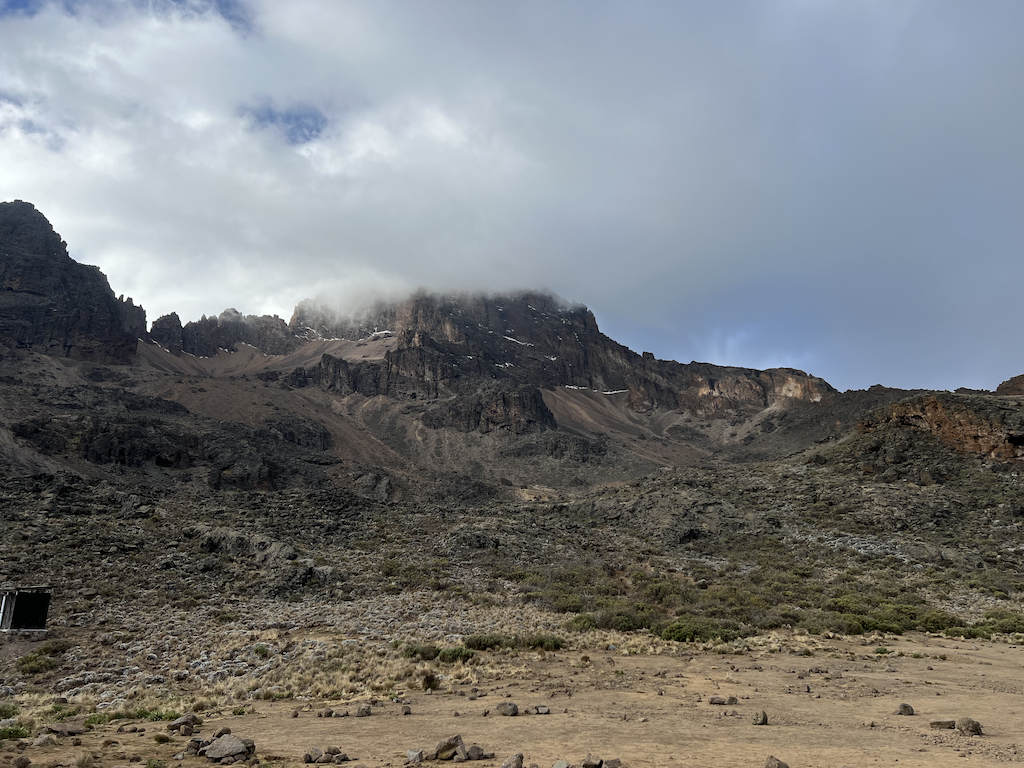
Mawenzi Peak is an extinct volcano with a collapsed cone, giving it a sharp profile. The Mawenzi climb is technical, steep, rocky, and dangerous. Tonya climbed Mawenzi as part of climbing the five highest peaks in Africa.
Hallelujah and I did an acclimatization hike part of the way up Mawenzi Peak. It allowed me to test my leg when descending a semi-technical section.
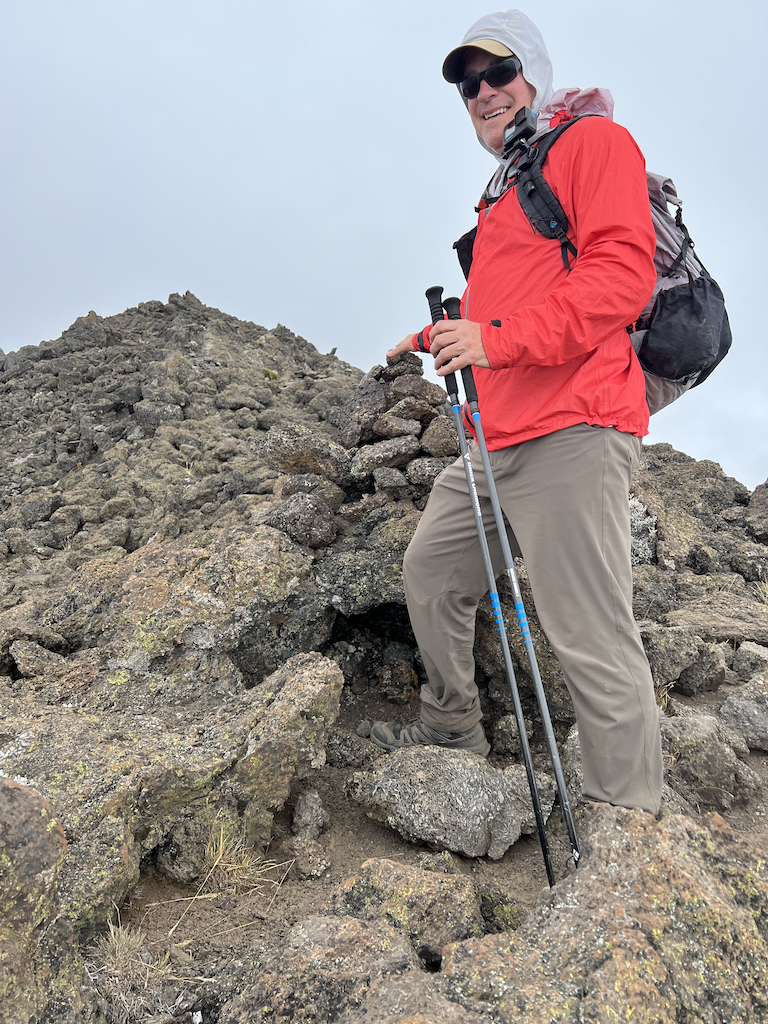
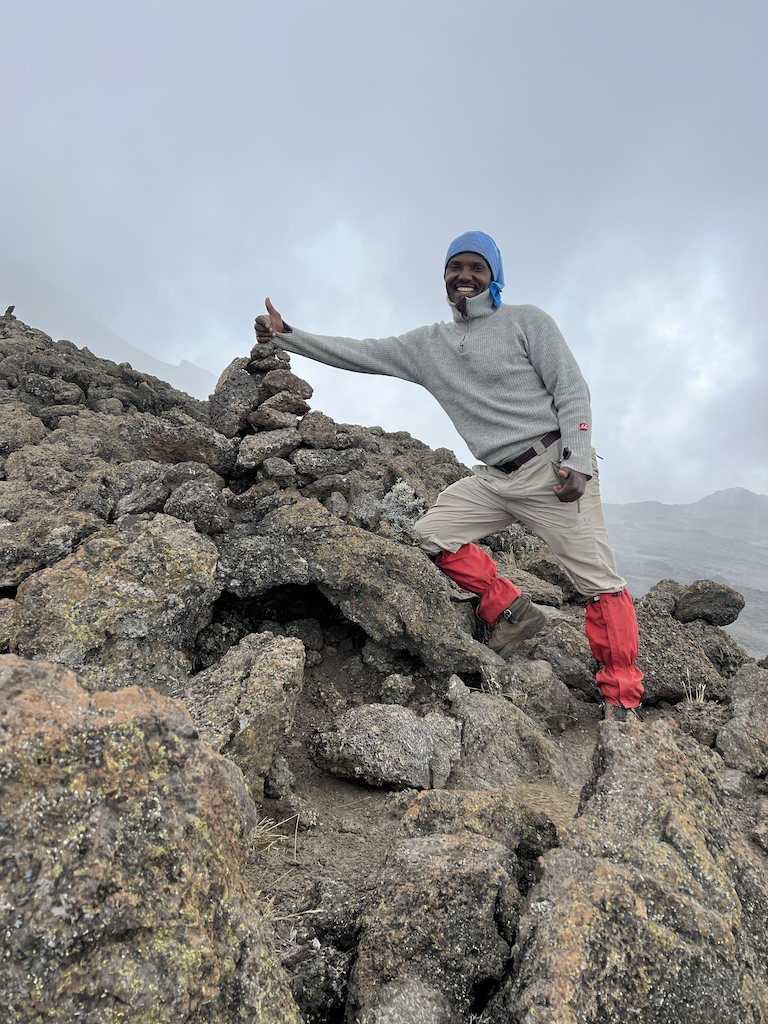
My sleep at the Mawenzi Tarn camp was fitful. I think it was the altitude because I couldn’t get comfortable. Once I got tired enough, I slept well.
We had about a 4.5 miles hike to Kibo Hut camp (15,490’) and less than 2,000’ to climb. Heading out of Mawenzi Tarn, we descended for about 400’ before climbing a small ridge and another slight descent before getting to “The Saddle.” We crossed a small plain that locals call “The Saddle” that links Mawenzi and Kili. I saw Cape Buffalo prints in this area, and Hallelujah said that the buffalo migrate across the saddle. Many animals trek across the 15,000’ saddle to move between water sources. Brad said he saw a lion in this area on one of his expeditions.
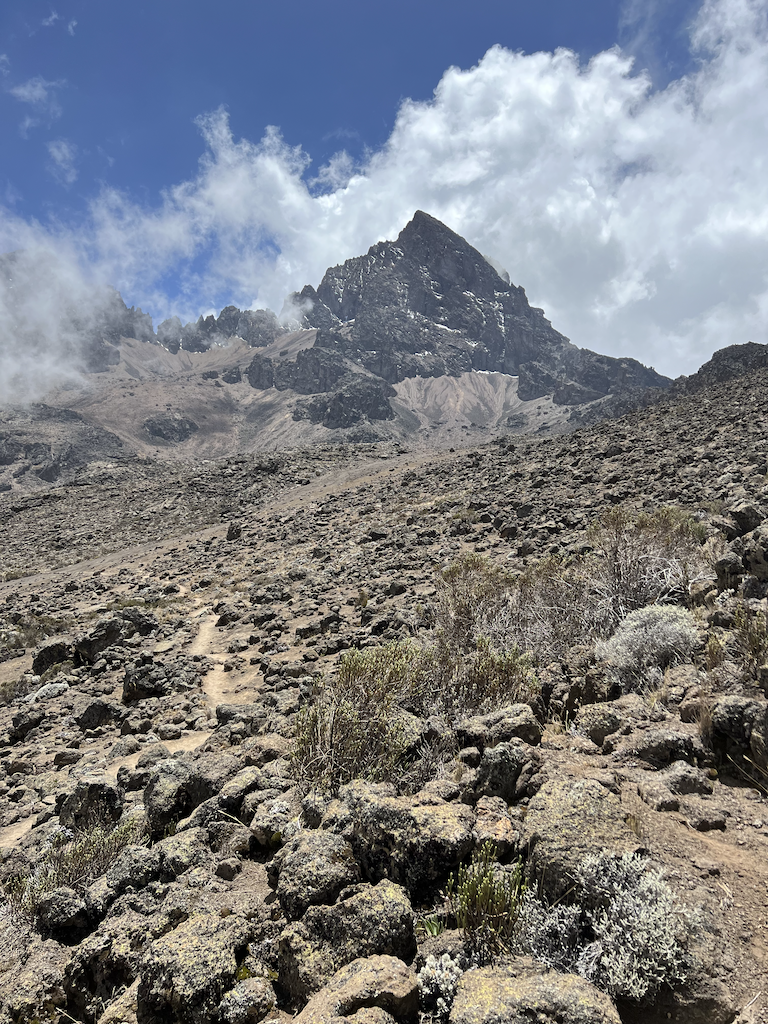
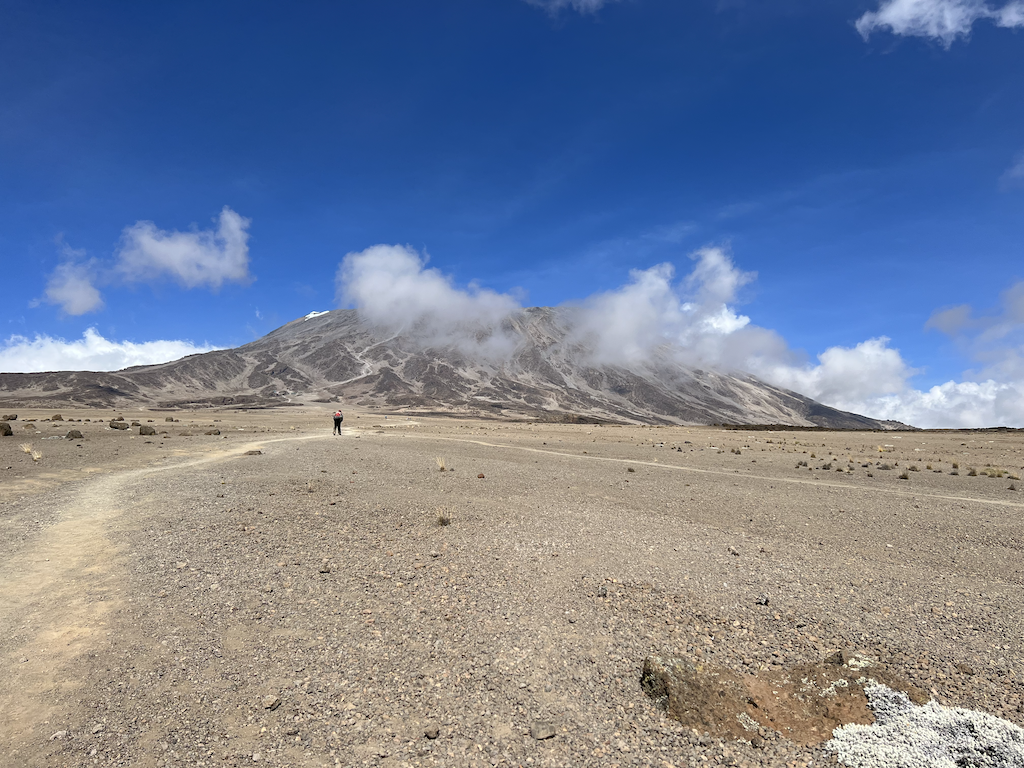
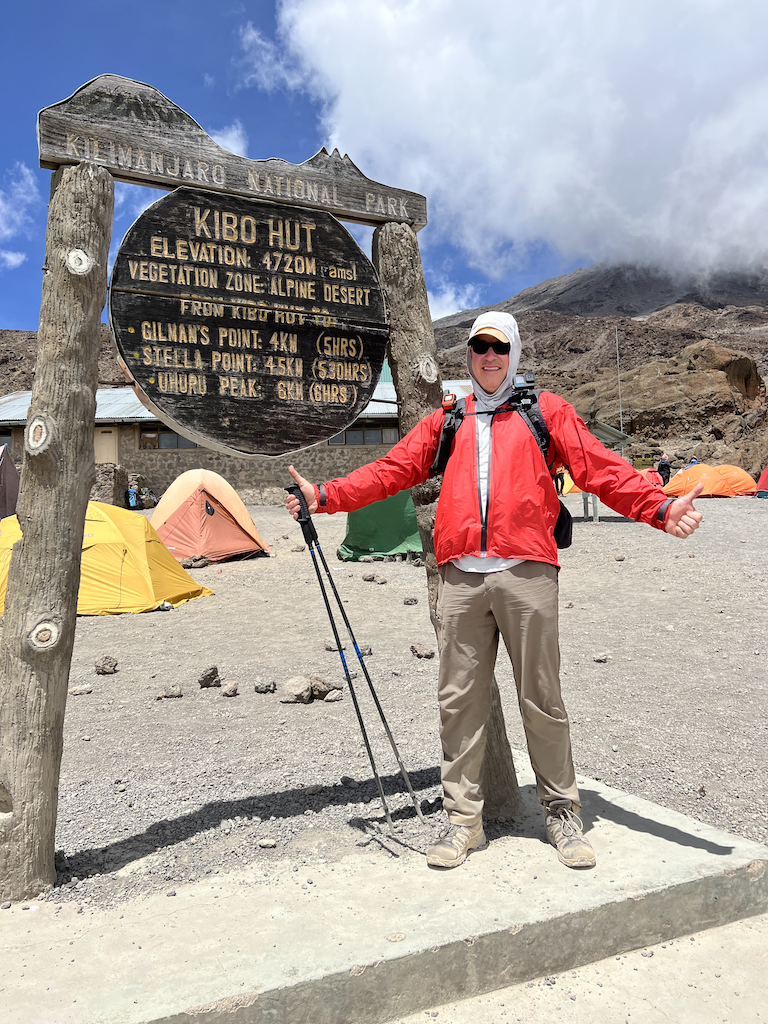
I felt good, and Hallelujah and I wanted to get to Kibo to rest because sleep that night would be short. Kibo was a choke point and was crowded. The people that took the Rongai and Marangu routes converged at Kibo Hut.
Summit day was different from the other hiking days. Only Hallelujah and I summited while the other teammates chilled at base camp. We started at midnight so that we would reach the summit at sunrise. The peak was close, around 4 miles from base camp (Kibo Hut), but was also steep, with about 1,000 ft of ascent per mile.
The climb from Kibo to Gilman’s Point (18,885’) is challenging. At night, I only saw what my headlamp illuminated. There were no lights of towns, and the sky seemed overcast because I did not see stars or the moon. Once we got to Gilman’s Point, the steep climb was over. We took a break to drink from a thermos of hot tea, and I ate a bar. We also froze. I estimate the temperature was 0F.
Gilman’s Point is one of three official summit points on Kilimanjaro. Some climbers end their climb at Gilman’s Point because of fatigue and altitude sickness. There is one hour to go to Uhuru Peak (19,341’), the highest point on Kili near the crater rim.
We had a few spots to scramble over after Gilman’s Point, and the sun had not risen. I only saw what my headlamp brightened, but we soon saw lights from the surrounding villages. Our next milestone was Stella Point (18,885’), where the Machame, Lemosho, Umbwe, and Shira routes converge to our path, and I could see the headlamps of the trekkers taking these routes.
After Stella Point, the route had more people on it. Some people would stop and rest in the middle of the trail. Luckily, the guides worked things out, and Hallelujah and I could maneuver around the people and hike to the true summit. We got to Uhuru Peak at sunrise, which was perfect!
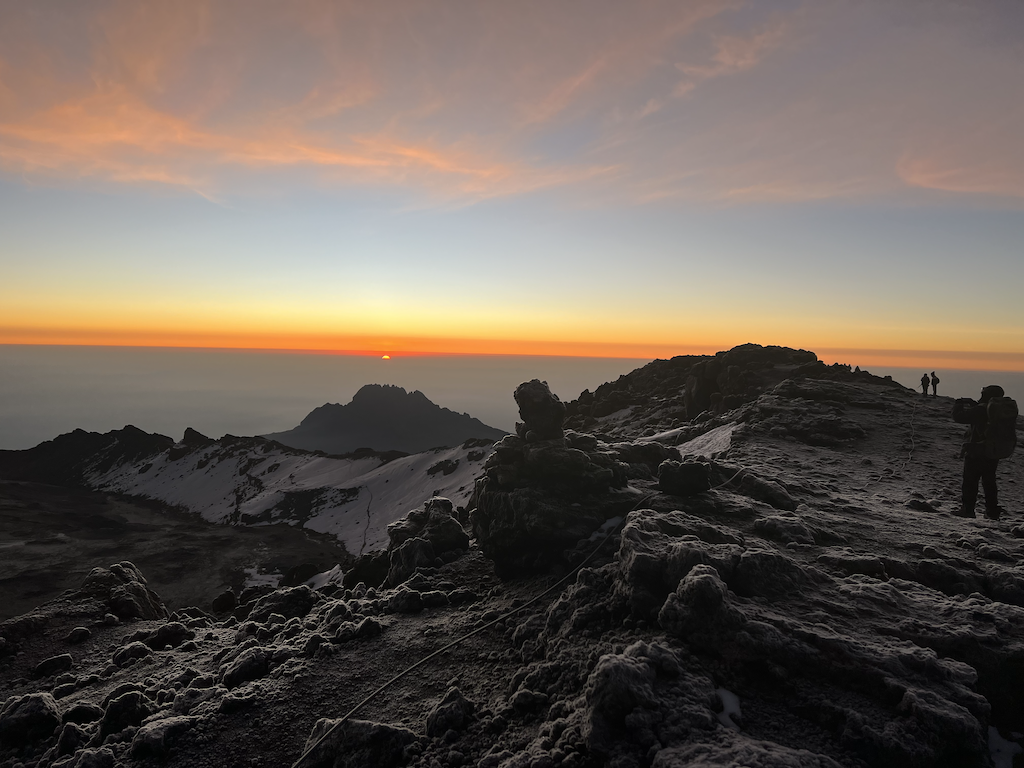
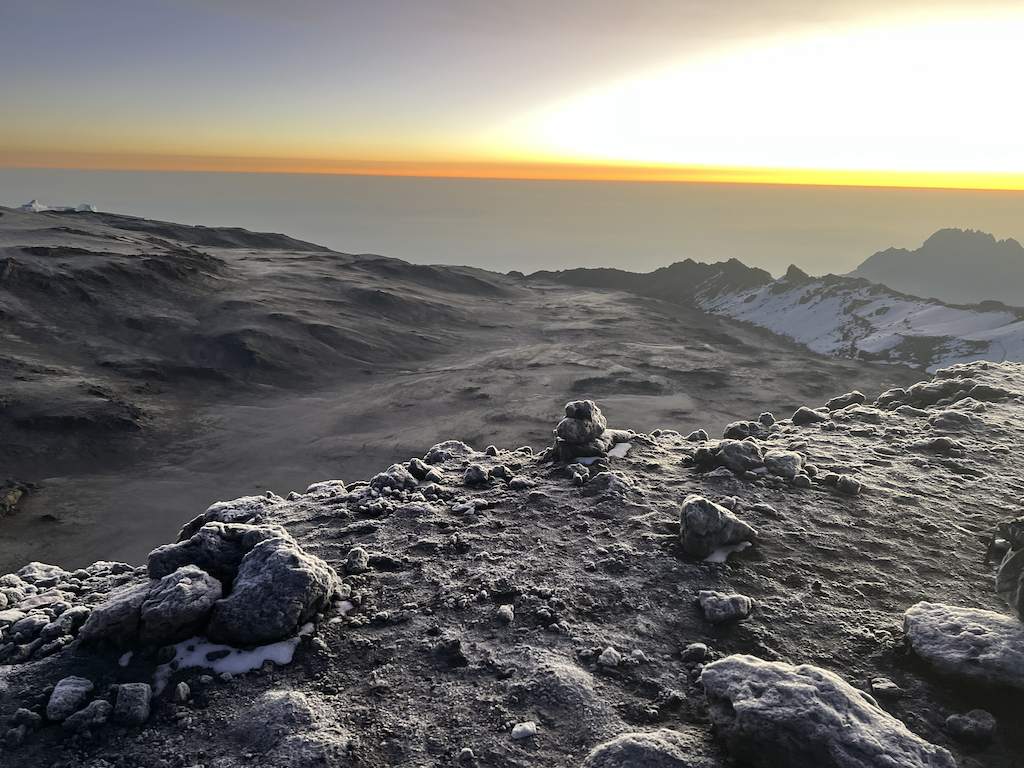
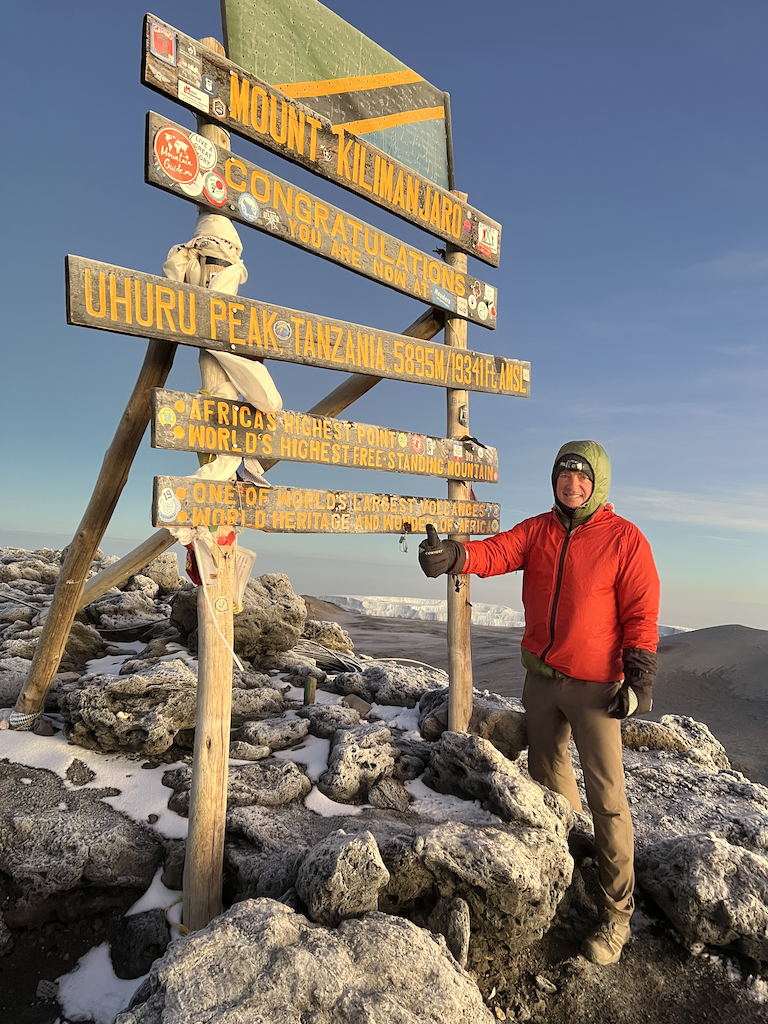
Getting to the summit at sunrise was simply amazing. Hallelujah has summited Kili hundreds of times. He seemed to know precisely the hiking speed we should do to get to the summit by sunrise. We had hiked together for five days, so he knew my ability, which he did not take for granted. I easily could have come down with altitude sickness on summit day. Throughout my time on the mountain, Hallelujah asked how I felt, and he observed how I was doing. Many people will not be honest with themselves, let alone others, to appear tough. Hallelujah would ask and observe.
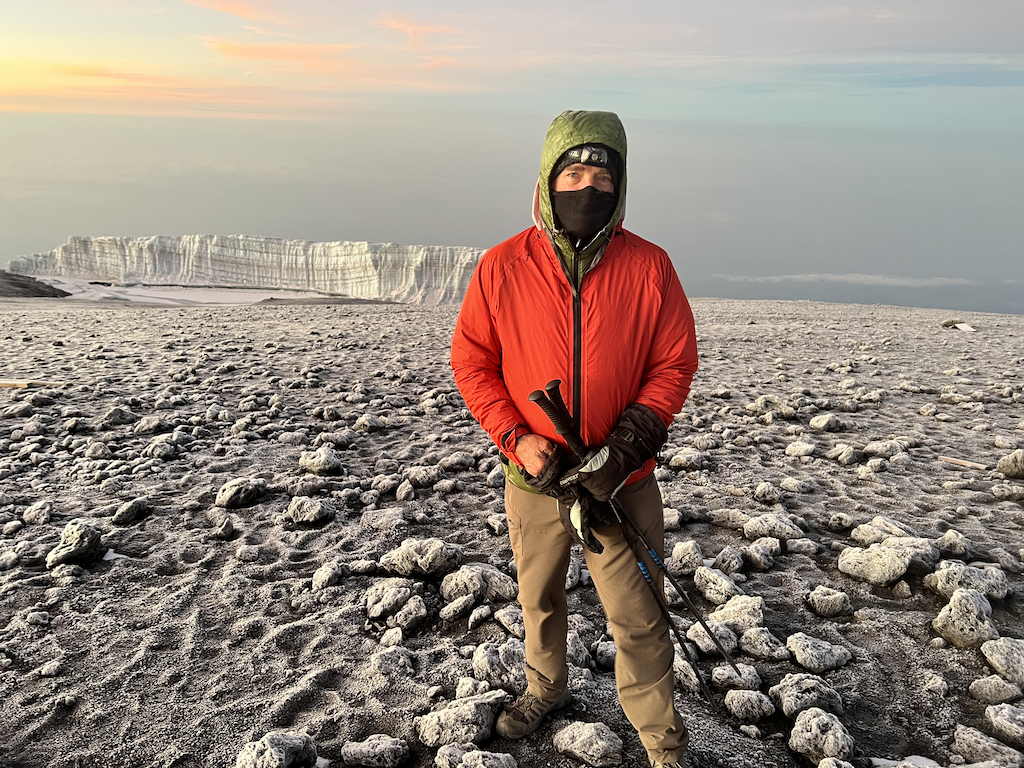
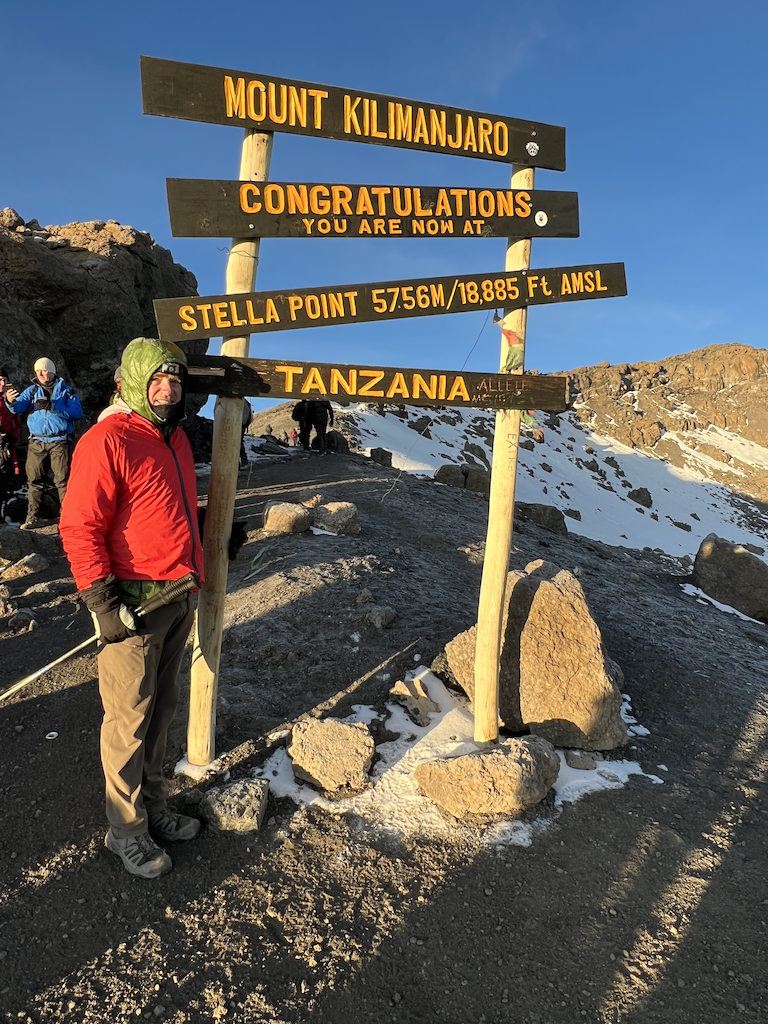
Pole’-Pole’ is Swahili for “slowly.” My guide, Hallelujah, would constantly remind me Pole’-Pole’ or hike slowly. Hallelujah’s job as a guide is to get me to the summit. Part of the guiding responsibility is to evaluate how well I acclimate each day and to monitor for Acute Mountain Sickness (AMS). Slowly hiking helps with acclimatization because exhaustion does not hide the effects of altitude. Another litmus test for the onset of altitude sickness is appetite. Early symptoms of altitude sickness are headache and loss of appetite. So, scarfing down food shows that I am doing fine.
Altitude sickness is no joke. Authorities helicopter evacuated two people from our base camp because of altitude sickness. When we returned to base camp after summiting, a dozen people had turned back from climbing to the true summit because of altitude sickness. I felt lucky because I could make the same trip tomorrow and have severe altitude sickness.
About ten people per year die attempting Kili. Being honest with yourself and your guide helps improve your odds of reaching the summit. I went in with the idea that I would report to my guide any ailment, no matter how minor. Guides also may daily monitor blood oxygen saturation. When I trained for Kili, I would go from 5,400’, where I live, to over 12,000’ in frigid temperatures. On one hike, I climbed from 9,500’ to 11,500’ in 20 mph winds and 45 mph gusts with windchills to -20F. I was lucky.
Brad had prepared a checklist that included suggested drugs and immunizations. Two prescription drugs were associated with altitude sickness, Diamox and Decadron. Diamox prevents altitude sickness, and Decadron is for severe altitude sickness. I started taking Diamox the day before starting the hike as directed. However, after the third day of taking Diamox, I stopped because my body did not like it. That day I visited every pit toilet. Luckily, I never got altitude sickness. I never even felt shortness of breath.
The Tanzanian government certifies guides that include knowledge of all aspects of Kilimanjaro, from hike routes, medical issues, plants and fauna, animals, geology, and emergency procedures.
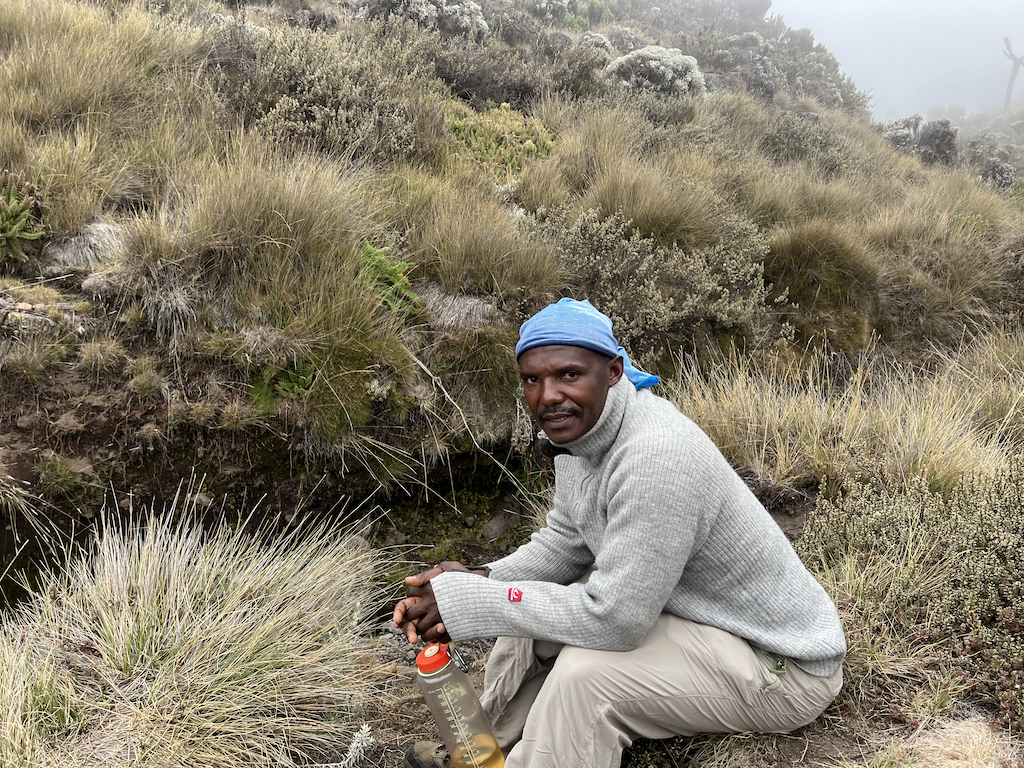
We spent about 30 minutes at the summit. We took pictures, and Hallelujah explained the geology and history of the mountain, including spiritual significance to the indigenous people through history, the glaciers, and the impact of global warming.
Once we started down, Hallelujah began to run, which caught me by surprise because several days earlier, I said that I often run on the descents. Hallelujah was adamant that we do not run down. We could not run down the entire way because of scrambling over rocks or through snow obstacles, but when we could, we did. I asked why we were running, and he simply answered, “Running down is good. We can.”
Since we hiked to the peak in the dark with only our headlamps for illumination, the descent in daylight was fantastic, like a new hike. I could see the landscapes I missed while in the dark. I was delighted to make the summit. The temperature warmed as we descended, and I removed several layers.
When we got to a long sandy section, running became “slide and stride,” almost as fun as glissading. Ascending in the sand was challenging but a blast when descending. The technique was easy to learn. Stride and place one’s foot and let gravity add a couple of feet to the stride. While sliding, pick up one’s back foot to do another stride. Hallelujah was better at this. I slid too much a few times and didn’t bring my back leg up in time, putting me on my back knee.
We got back to camp at 08:30, and both felt good. The cook prepared a great breakfast and loaded us with lunch since we would descend to a camp at around 12,000′. As we descended from the summit, Hallelujah asked if I wanted to exit the park and forgo another night on the mountain because we felt good. I reasoned that I came to summit Kili, and another night on Kili was unnecessary. I did not need to acclimate, there was nothing new to see, and the team could get to see their loved ones a day early. We went down the Marangu Route (Coca-Cola Route), exiting the park on the southeast the same day as we summited. We had a long, rewarding day.
Post-Trip
I trained by hiking in RMNP. I typically would start around 9,000′, and the highest I got was 12,300′. There was plenty of snow and cold temperatures. Usually, my training hikes topped out at around 11,500′. I got Covid 14 days before departure. Contracting Covid put a crimp on my training. Four days before I left, I did Twin Sisters in RMNP, ascending to over 11,000′ to see if I had any residual issues from Covid. Even though I still tested positive, I felt good. I tested negative before flying but wore a mask.
I took pictures and did not use my GoPro much because our daily hiking was short. I left the GoPro in the camp when we summited because I had not been using it. In hindsight, some videos while striding and sliding would have shown what I experienced.
I gave Hallelujah the two Nalgene bottles I brought. I should have traveled with more gear I do not use, so the team could use it or sell it for extra cash. Hallelujah needed the bottles.
The sense of accomplishment I felt was high. The unknowns I had are gone. I feel better in my abilities, having experienced high altitude. I want to do more firsts for me.
Fun Facts
Country music is very popular on Kilimanjaro. I heard Johnny Cash, Kenny Rogers, Conway Twitty, and others from the guides, cooks, and porters.
Fruits (bananas, pineapple, oranges, limes, lemons, and passion fruit), vegetables, legumes, and spices (tomatoes, potatoes, corn, beans, garlic, ginger) are ripe and fresh.
Fresh eggs are standard on the mountain.
Cooks serve popcorn almost every day for an afternoon snack.
“Asante Sana” is Swahili for “Thank you very much.”
“Kirabo” is Swahili for “You are welcome.”
“Jambo” is a standard greeting.
Water sources may be more than a mile from camp.
Boiled water is the standard purification method for drinking water. I drank much tea.
Tea and coffee are grown locally.
Kilimanjaro National Park does not allow plastic disposable bottles on the mountain, regardless of reusing them.
